With its breathtaking natural wonders, unique geological features, and rich cultural heritage, Iceland offers an unforgettable journey for adventurers and nature enthusiasts alike. The chance to witness the Northern Lights, soak in geothermal hot springs, explore lava fields, and visit a plethora of waterfalls add to its allure.
When I started compiling this list of best things to do in Iceland, I never realised it would end up being this long. For such a small country, it packs an almighty punch!
North Iceland
North Iceland, known for its captivating beauty and diverse landscapes, encompasses much of what South Iceland has to offer but without the crowds.
Anchored by the vibrant town of Akureyri, often dubbed the capital of the north, this region boasts a rich tapestry of natural wonders. From the thundering cascades of Goðafoss to the otherworldly landscapes around Lake Mývatn, this region is a playground for nature enthusiasts. It’s also a prime destination for whale watching, with Húsavík being a renowned hotspot in Europe.
Here’s what to see and do in North Iceland:
1. Experience the power of Dettifoss – Europe’s most powerful waterfall
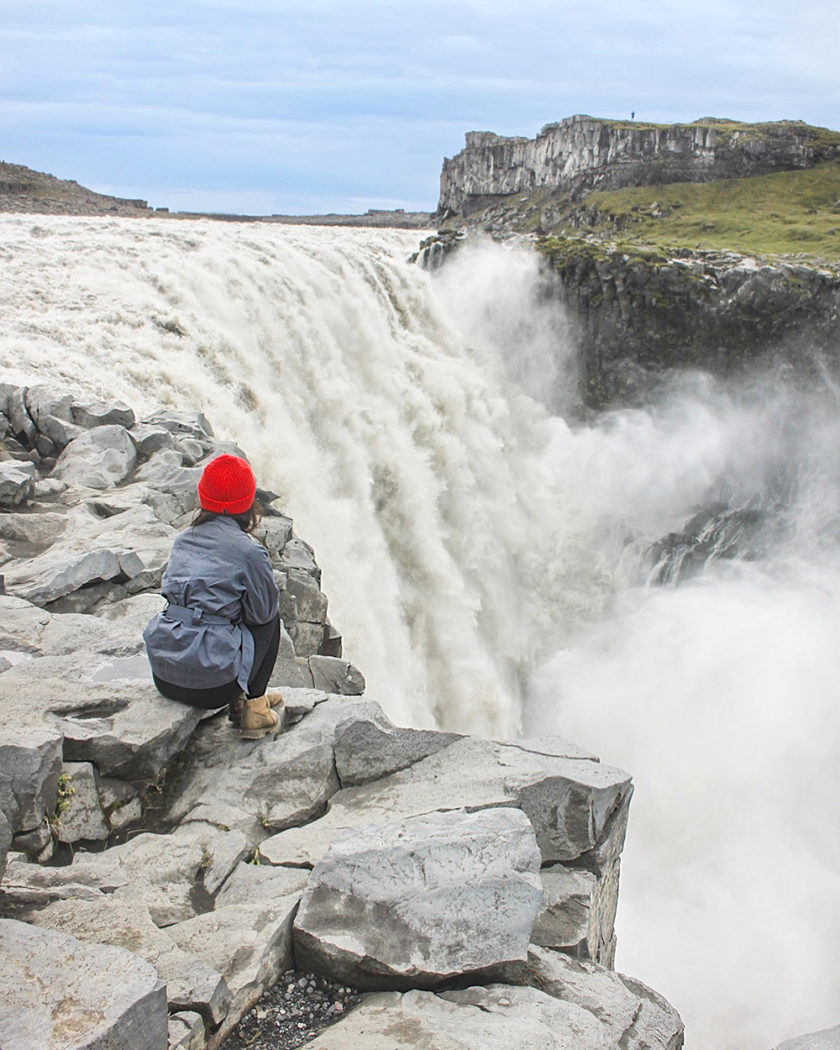
To experience the wrath of Mother Nature go to Dettifoss. Believed to be the most powerful waterfall in the whole of Europe with a colossal 500 cubic meters of water falling each second! So powerful, you can feel the ground shake as you get closer and hear the velocity of water crashing into an earth-shattering abyss. Easily one of Iceland’s most extraordinary natural attractions, Dettifoss was famously immortalised in the opening scene of Ridley Scott’s 2012 film, Prometheus.
2. Stop at the majestic Goðafoss
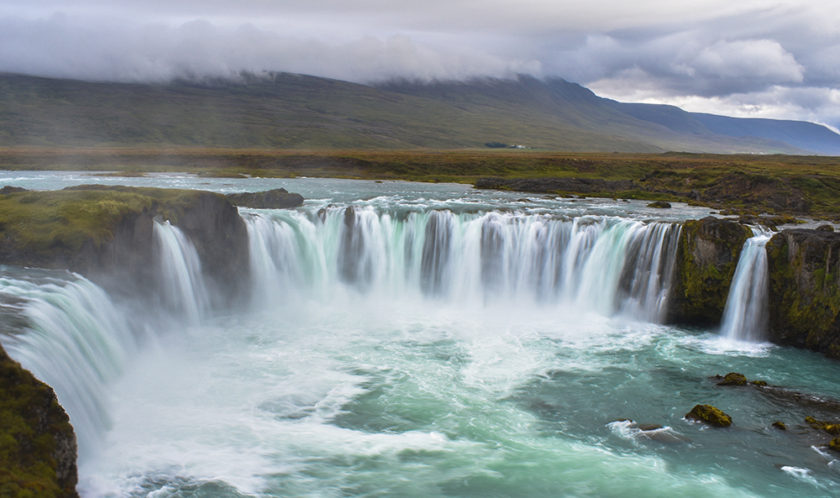
Another very impressive waterfall in North Iceland is Goðafoss, also known as waterfall of the Gods. Shaped like a horse-shoe with a large expanse of water cascading into the Skjálfandafljót River below, it’s one of Iceland’s most beautiful waterfalls. For photo opportunities it’s definitely worth crossing the river and walking to each side of the waterfall for different perspectives.
3. Hike up Hverfell Volcano
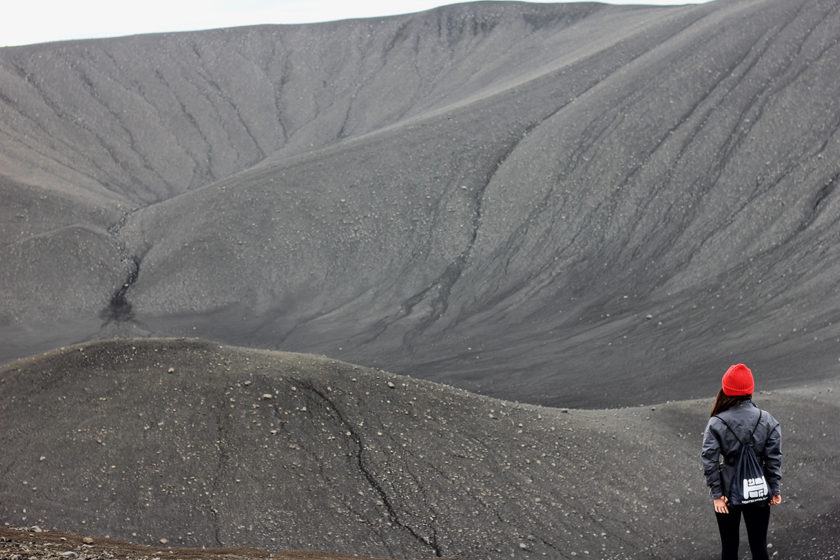
This volcano can be seen from miles away: broad, conical, black and shaped in a cone. Hverfell demands attention in an otherwise flat landscape. Formed around 2500 years ago when Hverfell erupted over the Myvatn region, you have the opportunity to take the short hike to the top of the crater for 360 degree views of the surrounding area.
4. See the quirky rock formations at Dimmuborgir
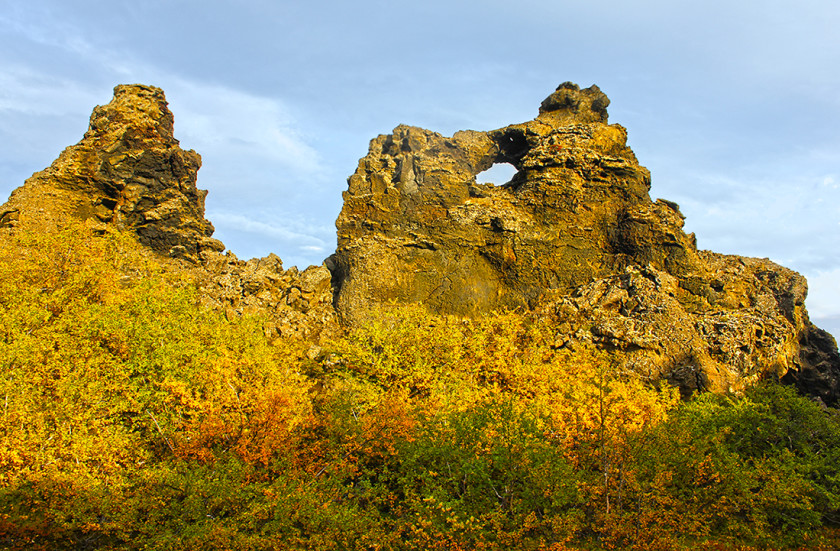
A world of its own; a park filled with bizarre lava formations. Dimmuborgir has inspired much Icelandic folklore. It’s believed this is where the earth connects with the infernal regions. So if there’s one place where you’re going to believe elves exist, it’s going to be here!
5. Huge bubbling mud pools at Hverir Geothermal Area
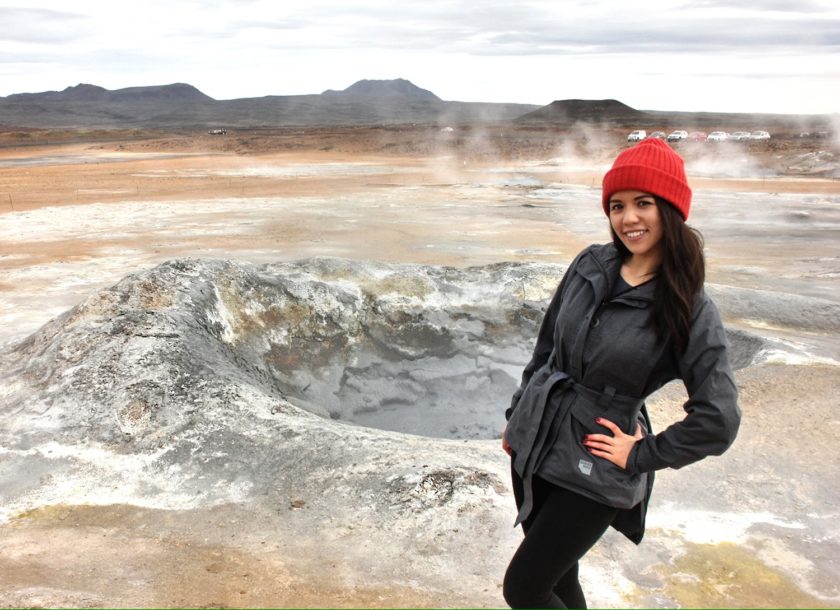
There’s a high chance that you’ll smell this place before you even see it! This high temperature geothermal area emits a strong aroma of rotten eggs haha. You’ll be amazed at huge, bubbling mud pools, fumaroles and sticky red soil. This is easily one of my favourite places in North Iceland and shouldn’t be missed – even if you do need to pinch your nose while visiting!
Read more: Hverir Geothermal Area In North Iceland
6. Journey to Hell
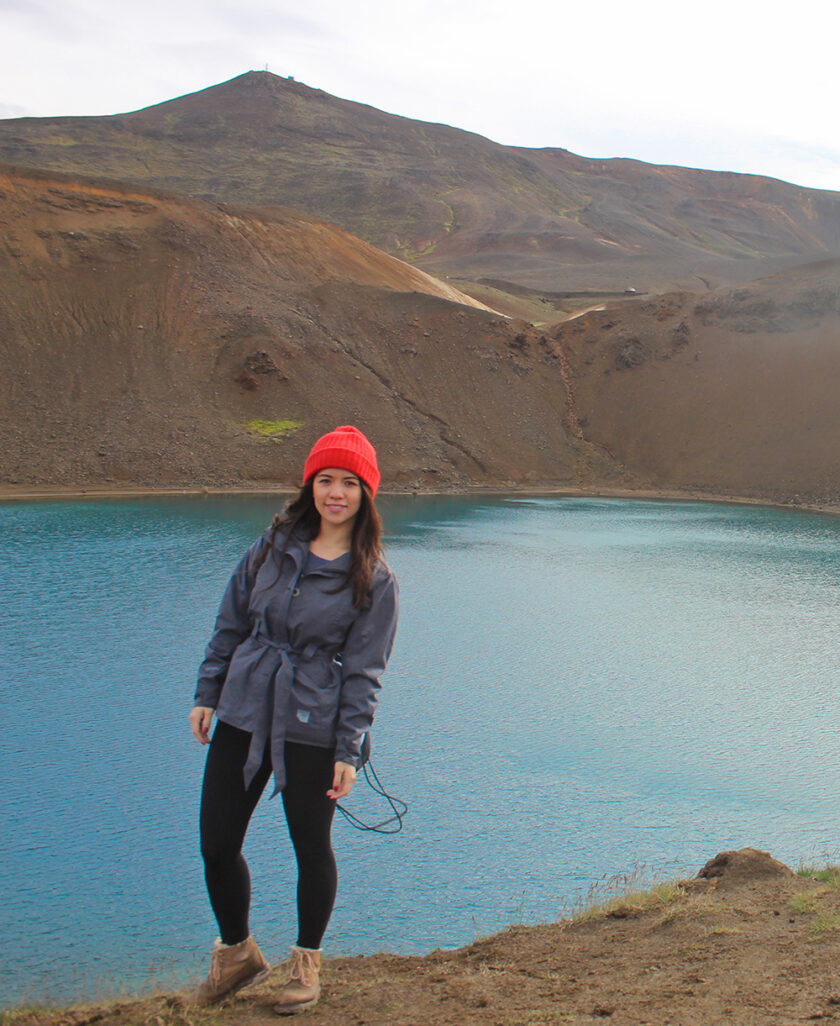
Going to hell is no longer as scary as it sounds!
Icelanders have a favourite word for gaping craters that blast out millions of tons of volcanic debris – víti, meaning hell. Translating to Hell’s crater, this explosion crater formed in 1734 by a massive eruption in the Krafla volcano. It became known as Myvatnseldar and lasted for five years.
7. Climb inside Grjótagjá lava cave
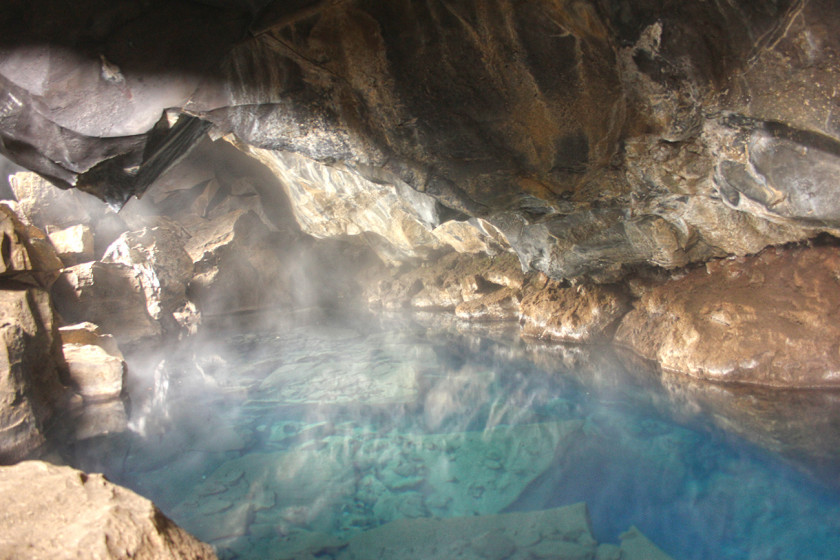
Entering through a crack in the ground, stop off at Grjótagjá lava cave for a few minutes to climb down into this low-ceiling tunnel harbouring a clear-blue steaming pool. If you’re here in the winter grab your swimwear, however, the pool is too hot to jump into during the summer – so enter with caution!
8. Soak in Myvatn Nature Baths
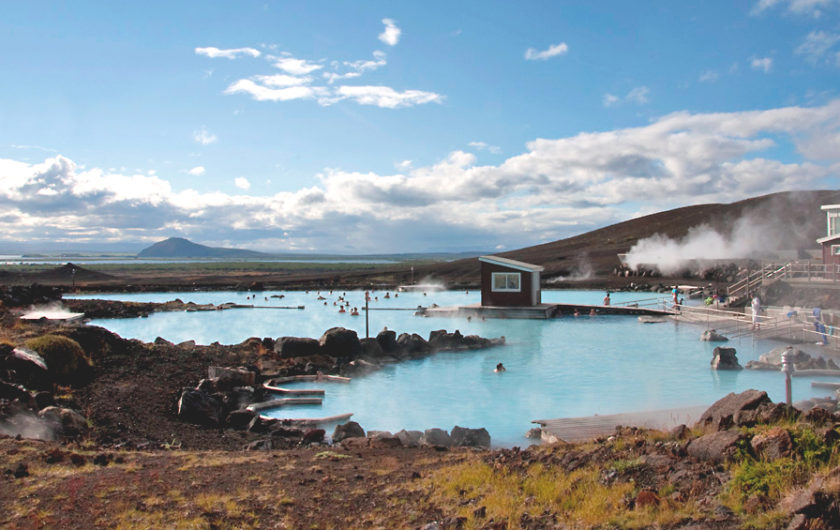
Imagine the Blue Lagoon on a smaller scale and with only a fraction of the people and you have Myvatn Nature Baths. After a day of hiking up volcanoes and traversing lava fields you’ll deserve it. There’s also a bar serving Icelandic beer – what more could you want?
9. Explore the Skutustadir pseudo craters
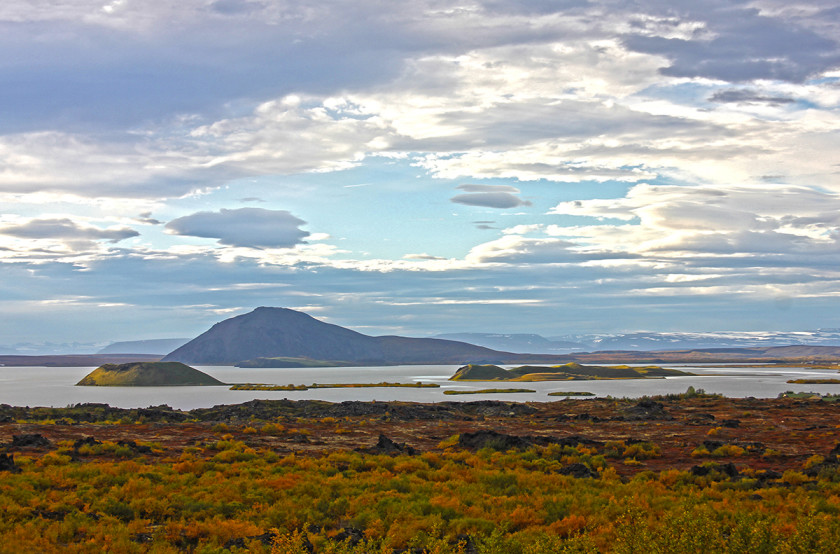
Iceland is often compared to Mars and this is just one reason why. Scientific interest in these pseudo craters increased after the discovery of the Athabasca Valles region of Mars, where lava flows superheated groundwater in the underlying rocks. These pseudo craters are among the largest and most beautifully shaped on Earth making here an ideal setting for some scenic hiking, but you’ll also be joined by midges that feed from the lake – you’ve been warned!
10. Climb the Basalt Rocks at Hofsos
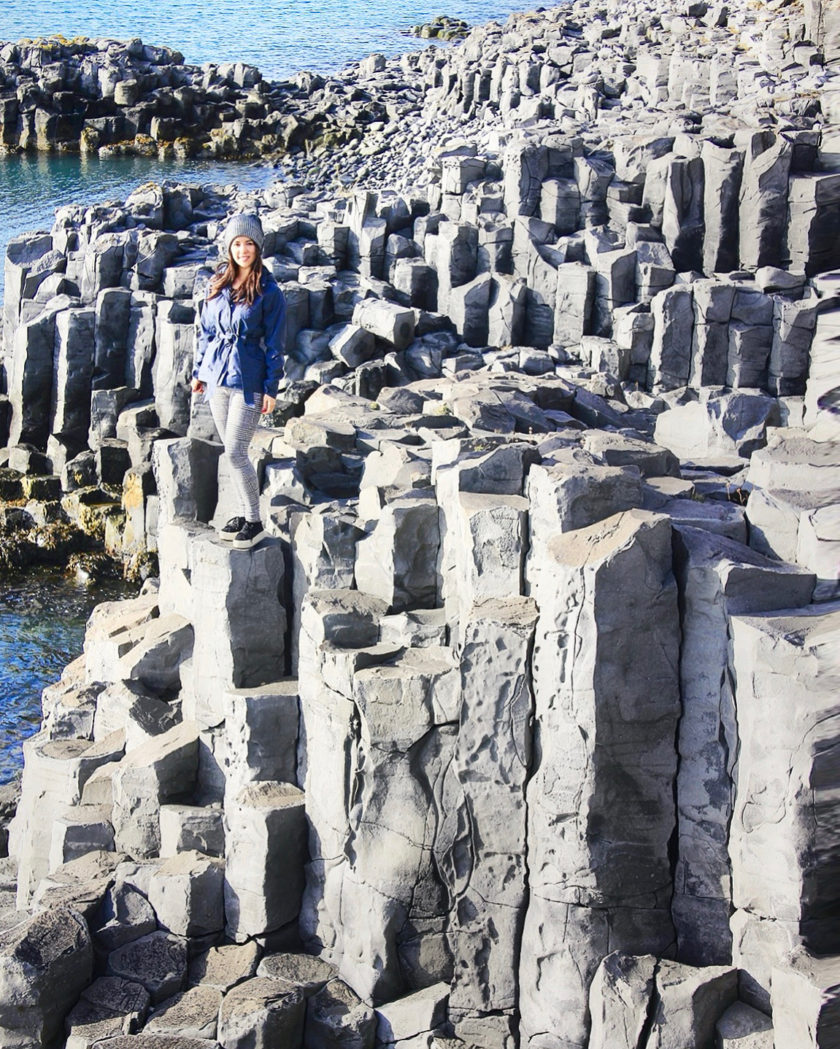
This tiny fishing port with a population of only 200 people is home to stunning coastal views. Most visitors come here to soak in the open-air pool overlooking the ocean, but the real attraction is the huge expanse of basalt columns stretching all along the coastline. Surprisingly, very little has been written about these basalt columns and I stumbled upon them completely by accident so you can imagine how happy I felt.
11. Relax at Gettislaug hot pools
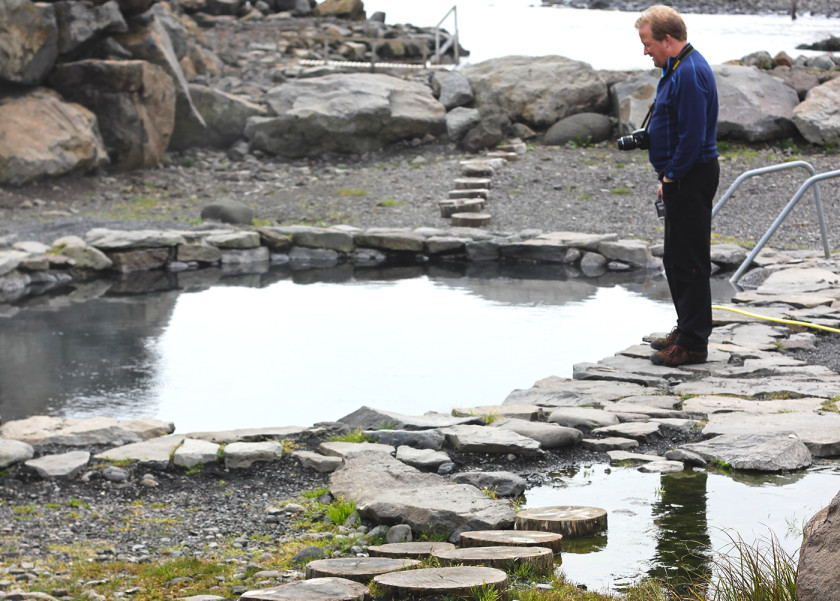
Nearby Hofsos you’ll discover Gettislaug hot pools which overlooks a huge fjord. Now located on private land, there’s an entrance fee of approx £3.50 and you can soak in the hot pools for as long as you like. There are several pools to jump between and there’s a very good chance of having this place to yourself when you’re travelling out of season like we did!
12. Visit the pretty fishing village of Siglufjordur
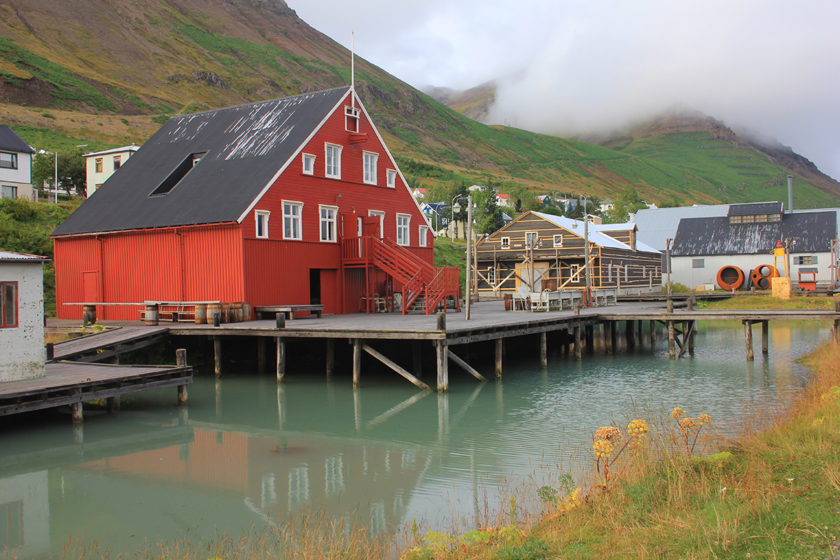
The small yet perfectly formed village of Siglufjordur was once nicknamed ‘Herring Town’ due to its abundance of herring which made the water look silver. The golden age of herring lasted just over 100 years, from 1867 to 1968, leading to an economic boom which Siglufjordrur was at the centre of. Once upon a time, the herring from this one town alone provided more than 20% of the country’s total export income.
Though there is no longer any herring, its heritage has been wonderfully preserved at the Herring Museum, complete with herring boats, factory and live re-enactments.
13. Explore Akureyri – the ‘Capital of the North’
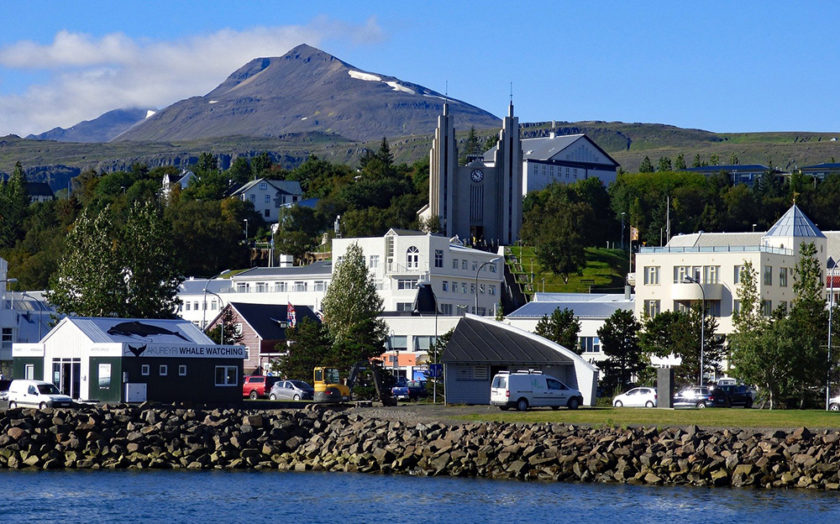
Iceland’s largest town outside of the Reykjavik area is dubbed the ‘capital of the North’ and is home to a modest 14,000 residents. On the edge of a fjord, Akureyri has a handful of decent restaurants, cafés, shops and museums. Akureyri is also North Iceland’s tourist hub, with the best selection of hotels and tour companies offering day tours and adventure trips of the surrounding area.
The city’s most striking landmark (like Reykjavik) is its cathedral which sits on top a set of steep steps, from where you can enjoy great views across the town and the fjord.
14. Hop on the ferry to Grimsey Island
North of Akureyri, the vibrant fishing port of Dalvik is the departure point for ferries to Grimsey Island. Straddling the Arctic Circle 40km off Iceland’s north coast, this lonely fishing outpost is barely five square kilometres in area. Guided walks reveal the island’s history and birdlife, and you can also hire bikes and bask in the midnight sun during summer.
15. Go inside Lofthellir Ice Cave
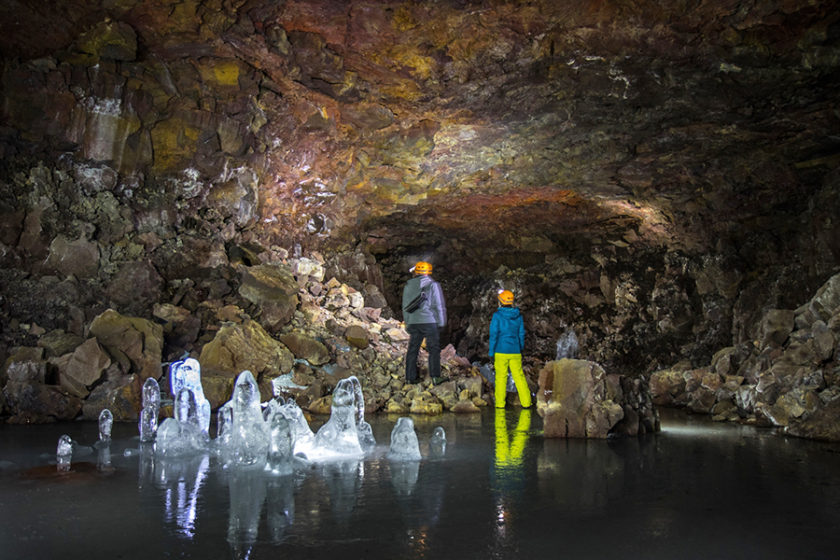
Photo © Saga Travel
Want to know what it looks like inside an ice cave? Regrettably I’ve not done this tour so I can’t personally vouch for it, but the tour with Saga Travel gets excellent reviews.
16. Visit the turf house museum at Glaumbær
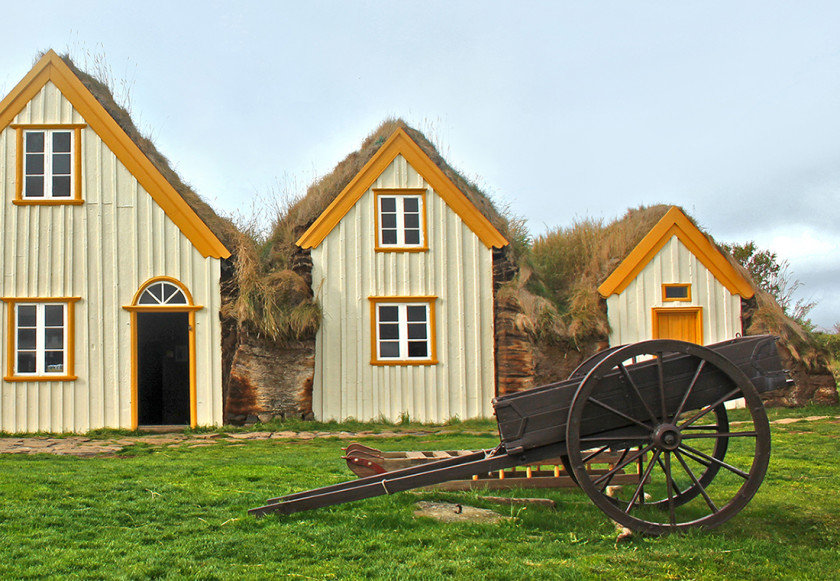
These gorgeous little turf houses at Glaumbær now operate as a museum. They are a great way in seeing how the past used to live. Made from peat it might seem primitive but this kind of cladding retains a lot of warmth, which is something the Icelanders didn’t have much of before they tapped into geothermal energy! Plus, just look how photogenic they are – you’ve simply got to go.
17. Go whale watching at Húsavik
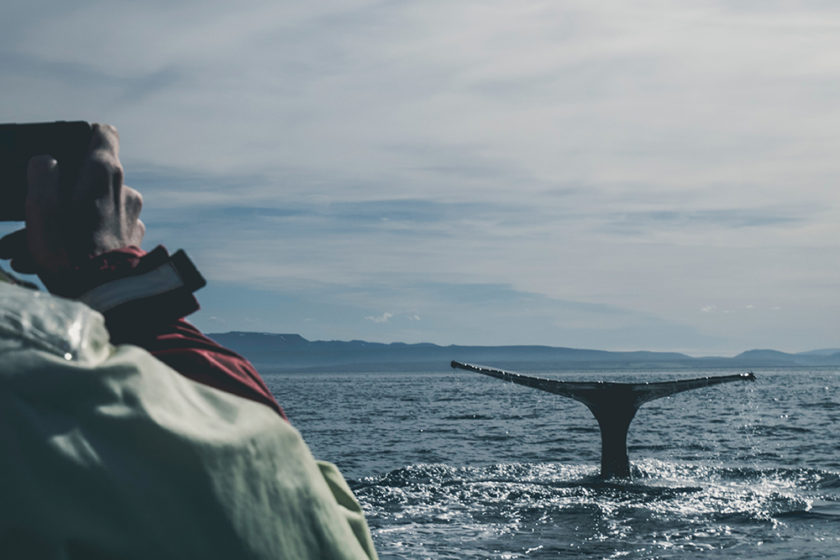
It’s not surprising that Húsavik has become Europe’s whale watching capital: Minke whales are seen on most boat trips in Skjalfandi Bay, while harbour porpoises and white-beaked dolphins are also common. Humpback whales are also regular visitors and there have even been close encounters with blue whales but you’d be considered very lucky to see one.
The harbour side Whale Museum has an interesting collection of artefacts and skeletons and is well worth a visit. If you’re staying in Akureyri, you can book beforehand here and the trip takes you all around this region.
18. Enrich your skin at GeoSea baths
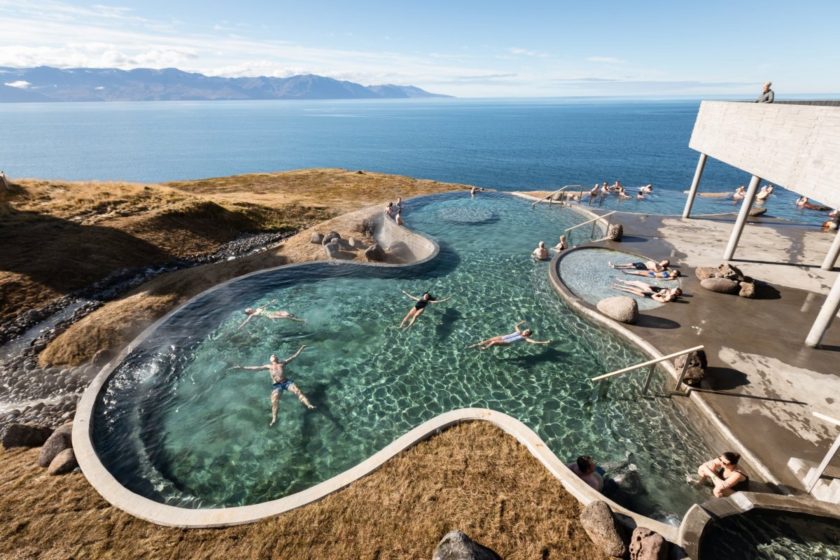
Also while in Húsavik, treat yourself to a relaxing time at the stylish GeoSea baths. For centuries, the geothermal heat north of Húsavík has been known to locals, who have utilised it for bathing and washing. Today, GeoSea allows you to soak in mineral-rich seawater while enjoying the view of a stunning mountain range and fjord. Book tickets here.
19. Visit Iceland's Stonehenge
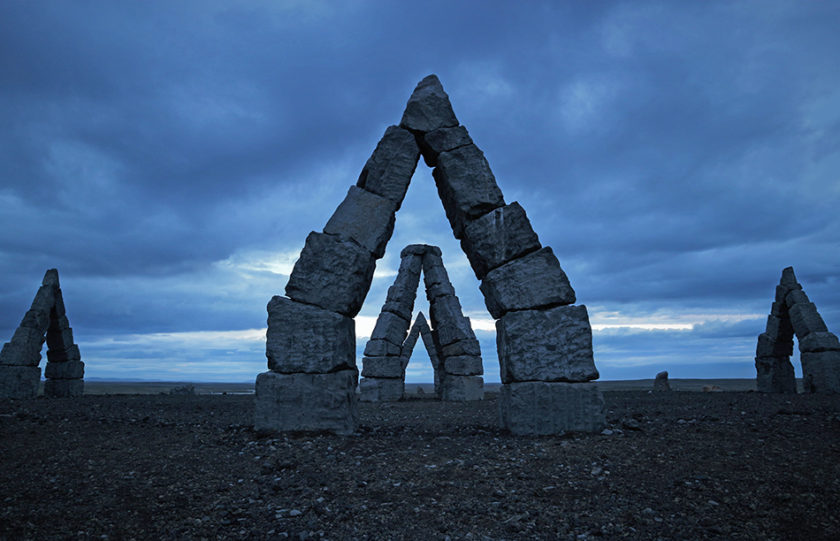
The Arctic Henge (Heimskautsgerðið) is found in Raufarhöfn, one of the most remote and northernmost villages in Iceland along the Arctic Coast Way. Amongst the purpose of this colossal sundial is to harness the Midnight Sun by the Arctic Circle. The inspiration for this mystical landmark is drawn from Norse Mythology, the Edda Poem Völuspá (Prohecy of the Seeress).
20. Hvítserkur – The Drinking Dragon
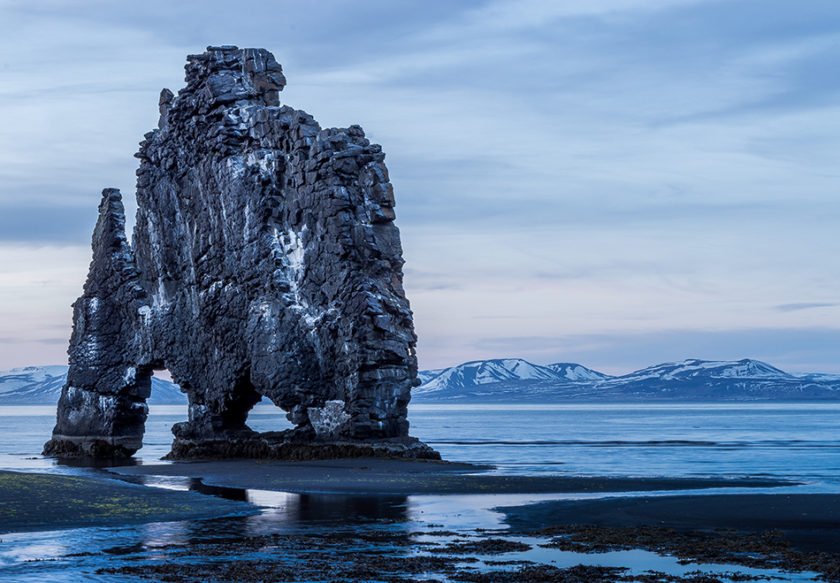
On Vatnsnes in Húnafjörður you can find an awesome rock formation called Hvítserkur. It is a 15 m high monolith eroded into a strange formation which most people think looks like a drinking dragon, though legend has it Hvítserkur was a troll caught by the sunrise while attempting to destroy the Christian monastery at Þingeyrar.
East Iceland
East Iceland can sometimes get overlooked because it’s further away from the most popular attractions and takes a little longer to reach if you’re flying into Reykjavik. However, it is no less worth visiting.
East Iceland offers a tranquil escape, far from the crowds, where nature’s beauty feels more remote, making it the ideal place to go for those seeking serenity and unspoiled vistas, lessen-known waterfalls, and lush valleys.
21. Stuðlagil Canyon
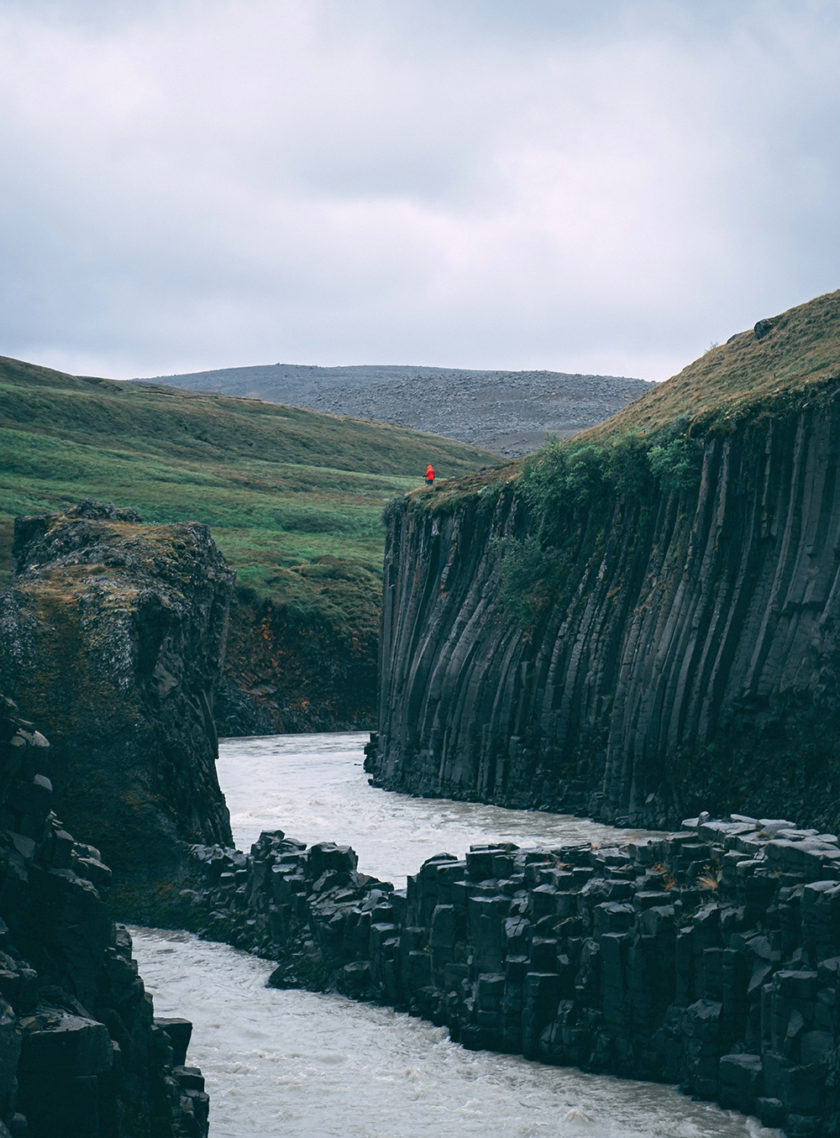
In Jökuldalur valley (Glacier Valley) in Austurland, East Iceland, there’s a marvellous natural site boasting one of the biggest and most beautiful basalt columns formation in Iceland: Stuðlagil Canyon!
In addition to this fascinating wall of basalt columns, it’s also interesting that they weren’t visible until recently. The valley was mostly underwater in the powerful Jökla River, until a dam was built which reduced the river’s water level significantly and in the process reavealed this gem to us!
Accessing the canyon is a bit of a hike but is certainly worth the effort, just always remember to stay safe.
22. The blue church of Seyðisfjörður
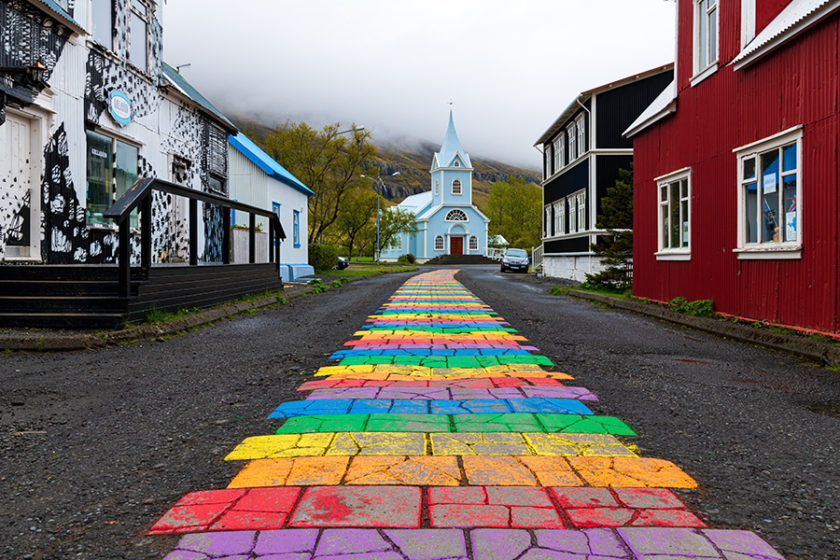
On any car journey around Iceland you’ll spot cute, little wooden churches but this blue one in Seyðisfjörður might just be the cutest. What makes it stand out is the multi-coloured path leading to it which has been added in recent years. It makes the whole little village sparkle and instagrammers can’t seem to get enough of it. Furthermore is the beautiful mountain backdrop which dominates the area.
23. Swim in Iceland's first floating pools
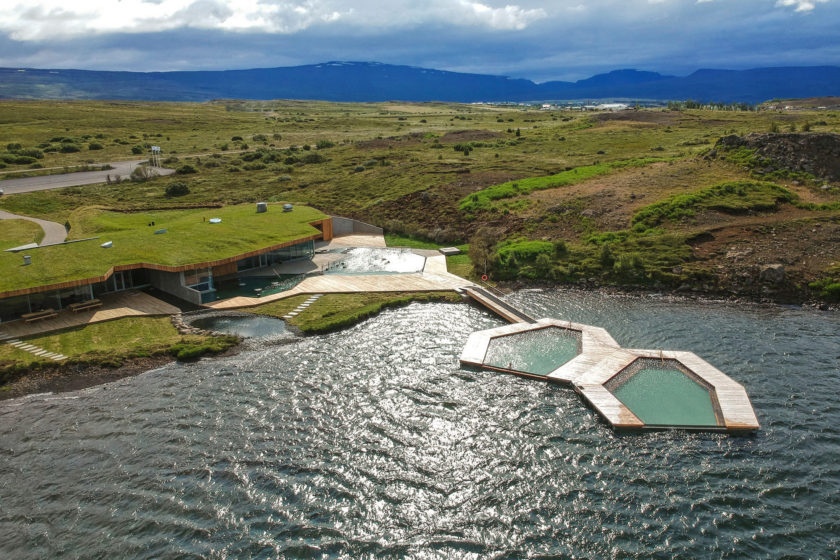
© Icelandictimes.com
Located only 5km from Egilsstaðir, you can enjoy Iceland’s first geothermal floating pools! Opened in the summer of 2019, Vök Baths offers a new bathing experience in the crystal clear water of Urriðavatn lake. Warm water streams from the hot springs deep under the lake into the floating pools where you can unwind and admire the views of nature all year round. And for maximum indulgence it comes equipped with an outdoor pool bar.
24. Visit Iceland's 3rd largest waterfall: Hengifoss
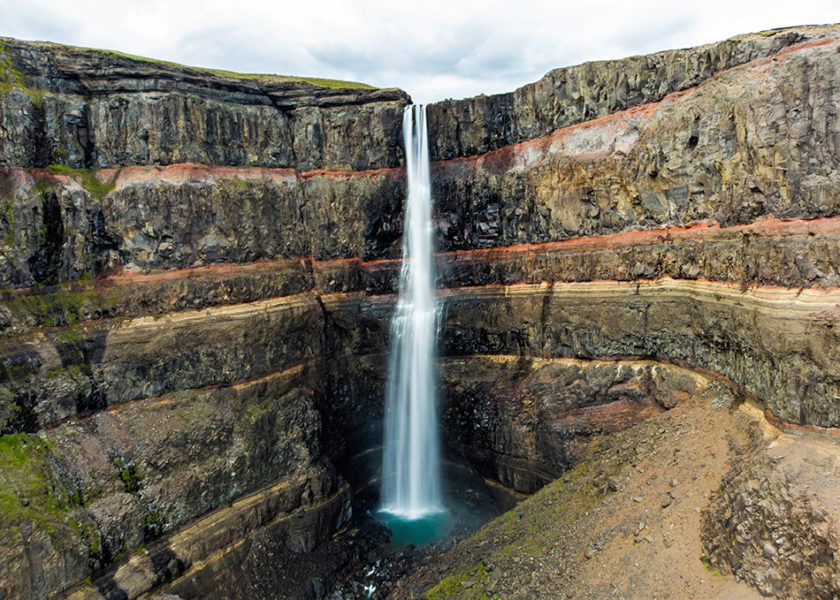
Measuring a drop of 128m, Hengifoss, which translates to ‘Hanging Falls’, is Iceland’s third highest waterfall and probably the popular attraction of East Iceland, It plummets into a beautiful gorge and its most distinct feature (aside its height) is the black and red basalt rock wall that sits behind the falling water. From the car park it is a 2.5 km hike uphill which takes approximately 50-minutes.
25. Hike to Stórurð aka the Land of the Giant Boulders
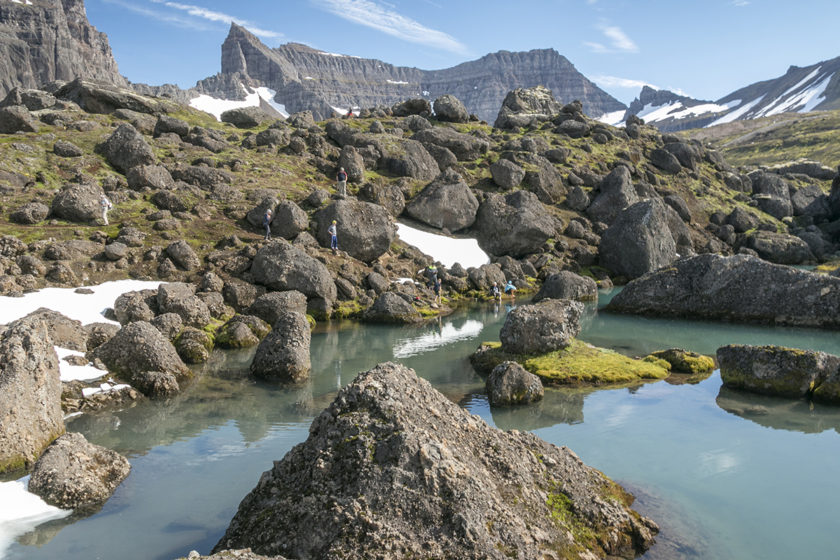
If you’re looking for another superb hike in East Iceland, you’re in for a treat getting to Stórurð. This land of giant boulders, scenic meadows and charming ponds lies below the small glacier west of Dyrfjöll mountains. This wonderful area can be reached in approximately 2.5-3 hours on foot from Vatnsskarð pass. It’s a very rewarding hike and a return trip will take the best part of the day so pack appropriately! There are also another four trails that lead to Stururð: Héraði, Njarðvík and two from Borgarfjörður.
South Iceland
26. See the eruption of Strokkur Geyser
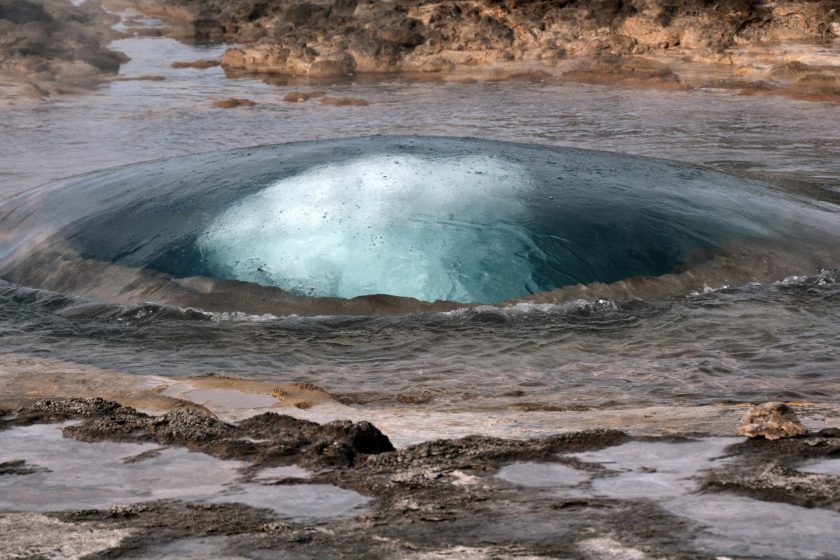
You will be left speechless as you watch Strokkur geyser erupt every 4-7minutes. With eruptions this frequent you are certain to get the shot you’re hoping for – watch as it begins to water begins to bubble, growing bigger and bigger, until it finally erupts metres into the air. Get your camera ready!
27. Feel the force of Gullfoss
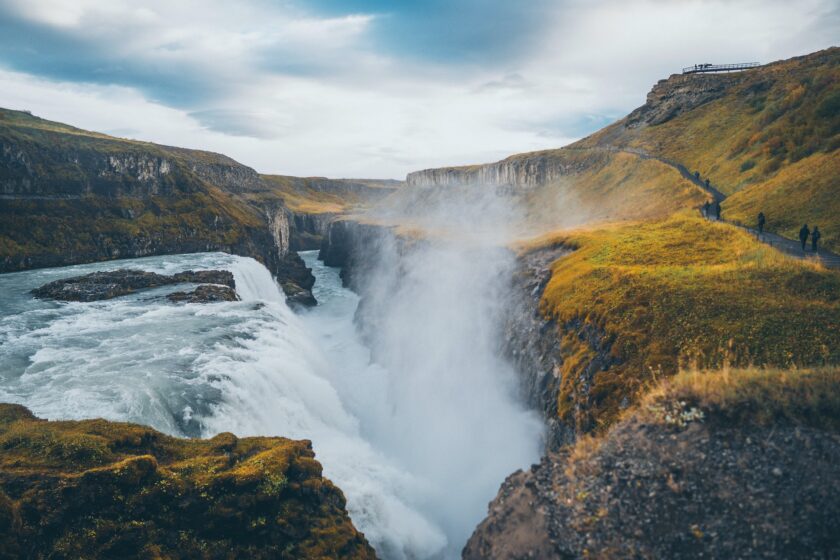
At first, all that can be made out is the ferocious waters that seemingly disappear into the abyss below, but as you carry on walking, the entirety of the falls comes into view. A huge cavern of water, 61ft wide, engulfs the water from above, as it crashes and churns down into it. To describe the waterfall as powerful would be an epic understatement.
28. Visit Thingvellir National Park, a UNESCO World Heritage Site
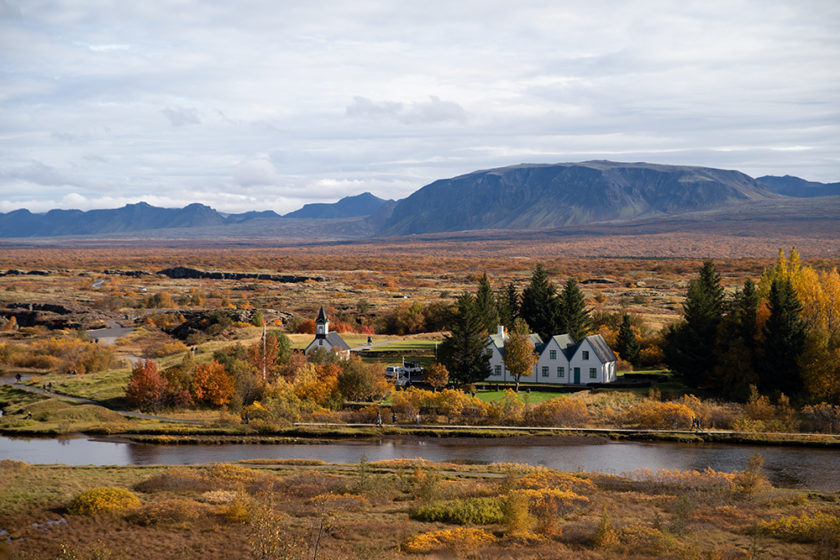
Thingvellir is a National Park rich in natural beauty and usually the first port of call on the Golden Circle route that famously consists of Thingvellir National Park, Geyser area and Gullfoss. It’s the founding home to Althingi, the parliament of Iceland in the year 930AD. For this historic reason it was inscribed into the list of UNESCO World Heritage Sites in 1994..
29. Walk the rim of Kerid Crater
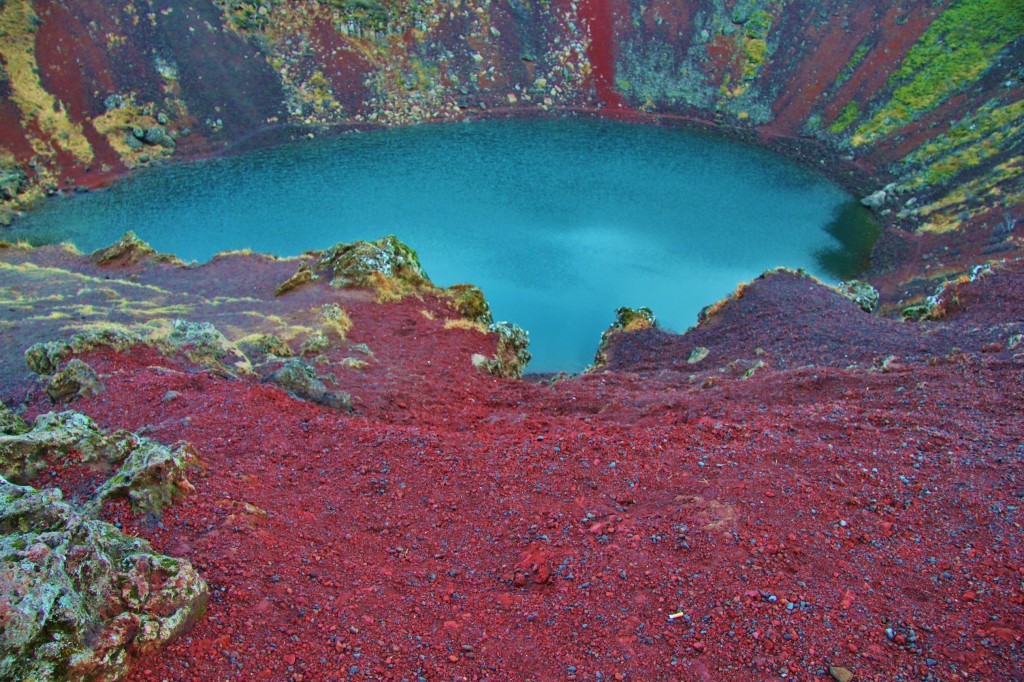
In Iceland, you can’t just have a stunning lake. No, it also has to be inside of a volcanic caldera. And sometimes that’s not even enough, so the showiest country in the world provides something like Kerid Crater Lake, which is a nearly neon blue lake sitting in a volcano surrounded by rare red volcanic rock. This is located along the Golden Circle route so it’s easy to visit along with Thingvellir National Park, Strokkur Geyser and Gullfoss.
30. Marvel at Harpa Concert Hall's unusual architecture
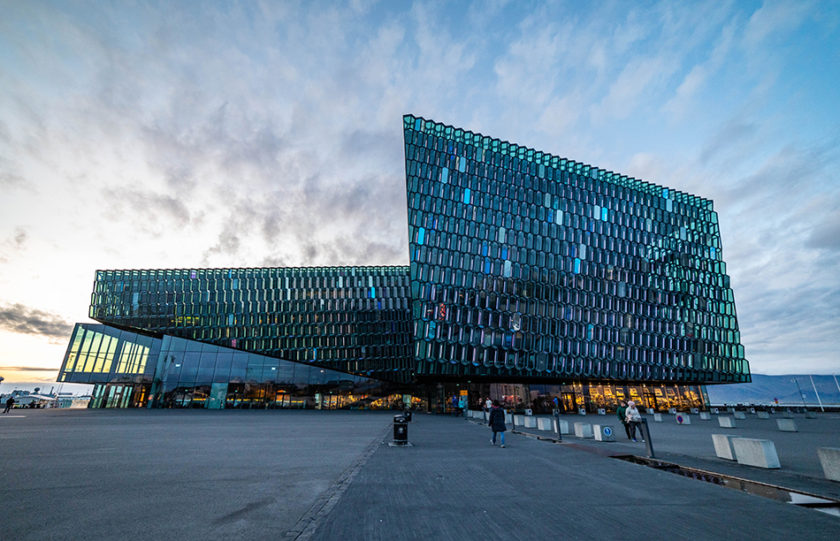
You don’t have to be interested in Scandinavian architecture to find this building impressive; its ‘honeycomb’ structure consists of a steel framework clad with geometric shaped glass panels of different colours. It’s difficult to gauge how large each glass panel is so I stood inside one in order to provide a perspective. Harpa is a multipurpose building that has four large concert halls, a café, design shop, bar and lounge and open spaces to hold a variety of cultural functions.
31. Have a giggle inside the world's only Penis Museum
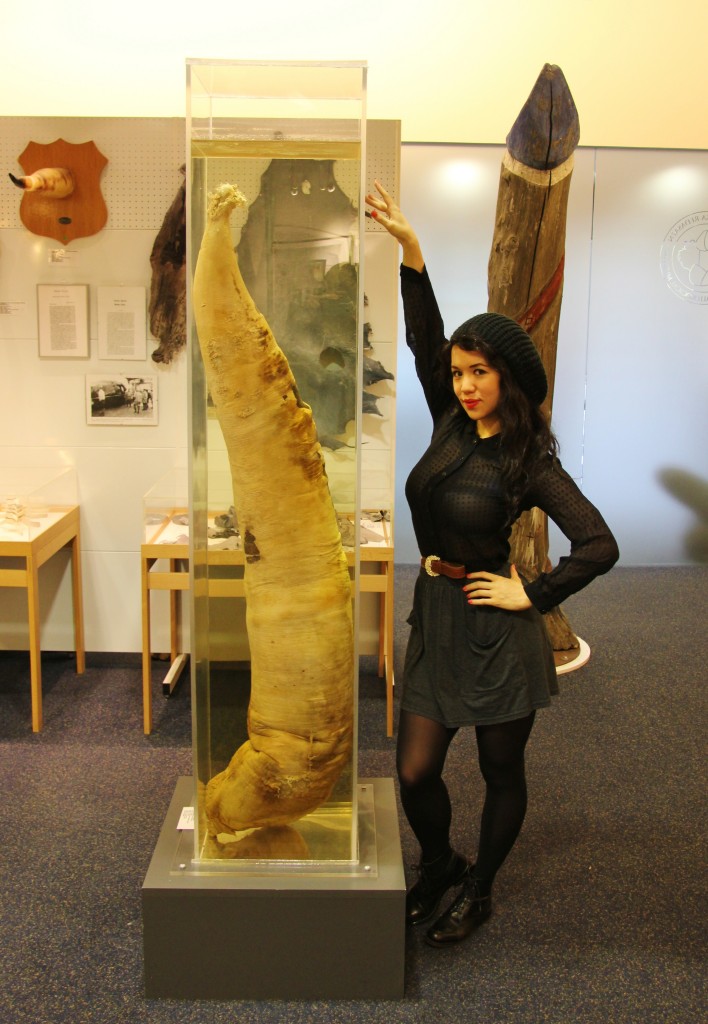
This is what I was referring to when I said there are some ‘downright strange’ things to do here. It’s not a place any visitor will forget anytime soon and showcases the humorous side that Icelandic people are noted for (the ex-Mayor of Reykjavik, Jón Gnarr, is also a comedian and actor!). This is one of my all-time favourite museums, not just because it’s filled with over 280 penises but because the owner happens to be an ex-school teacher(!). You couldn’t make this story up. The collection grew from a joke, as the school teacher let slip to his colleagues that he used a bull’s penis to whip cattle as a young boy. A sneaky peek inside the museum shows off a humongous whale penis, giraffe penis, and lamp shades made from bull’s scrotum, but for a more detailed account read my earlier post here.
32. Head up to Hallgrímskirkja Church for panoramic views of Reykjavik
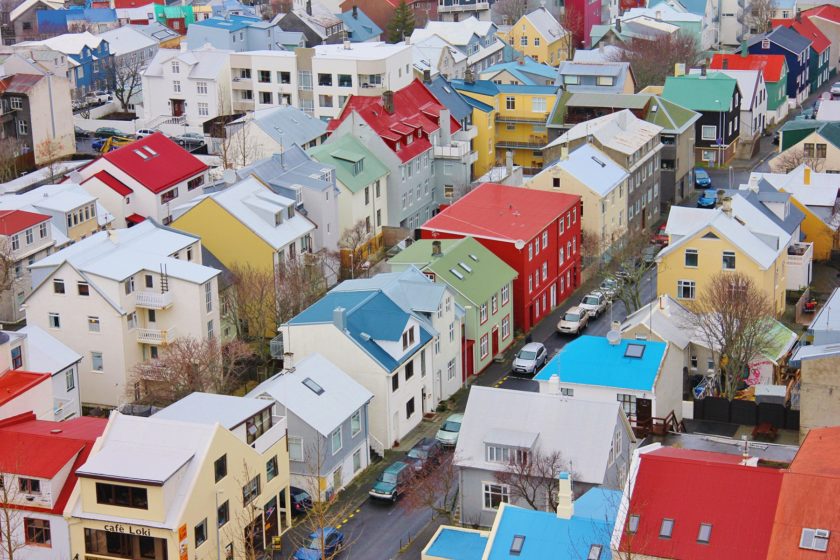
After visiting the Penis Museum you might want to repent at Hallgrímskirkja Church, but since I’m sure none of you lovely people reading this actually require a trip to confession then you should head straight up to the top of the church for a bird’s-eye view of the city. This view is the best way to see how quirky and colourful Reykjavik really is. Compact corrugated iron houses nestle next to large futuristic glass buildings to make it look as though Reykjavik was modelled from the buildings found on the Monopoly board – and an upgraded version of the game can explain any new and modern architecture.
33. Celebrate diversity

Take a stroll down Skólavörðustígur, one of Reykjavik’s main high streets. During Gay Pride a few years ago, the road was painted in the colours of the rainbow to celebrate the diversity of the LGBT+ community. The locals loved it and decided to permanently keep it so all visitors to Reykjavik can now enjoy the colourful street and the important meaning behind it.
34. Search for street art in the capital city
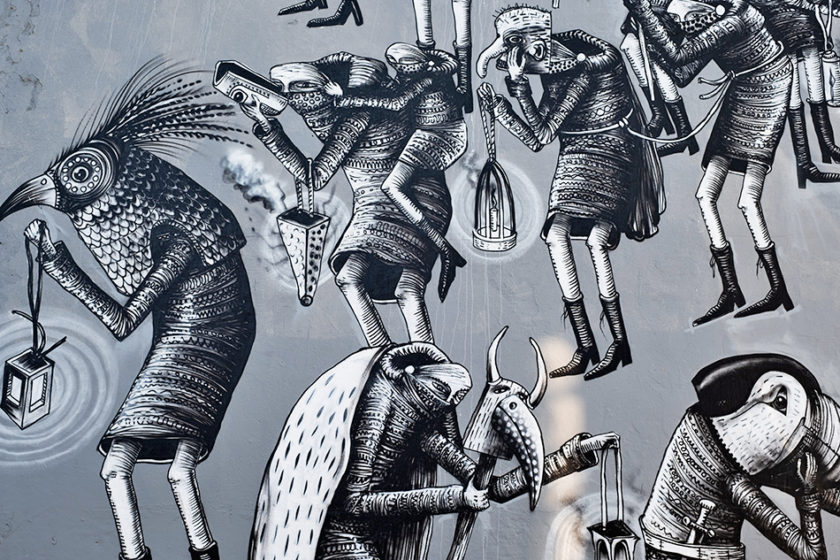
Looking at all the street art was one of my favourite things to do in Reykjavik. You don’t even have to go searching for it, you’ll end up stumbling across a decent amount just by wandering around the city. As well as the murals, you’ll find some fantastic sculptures too.
35. Feel like you're on Mars at Seltun
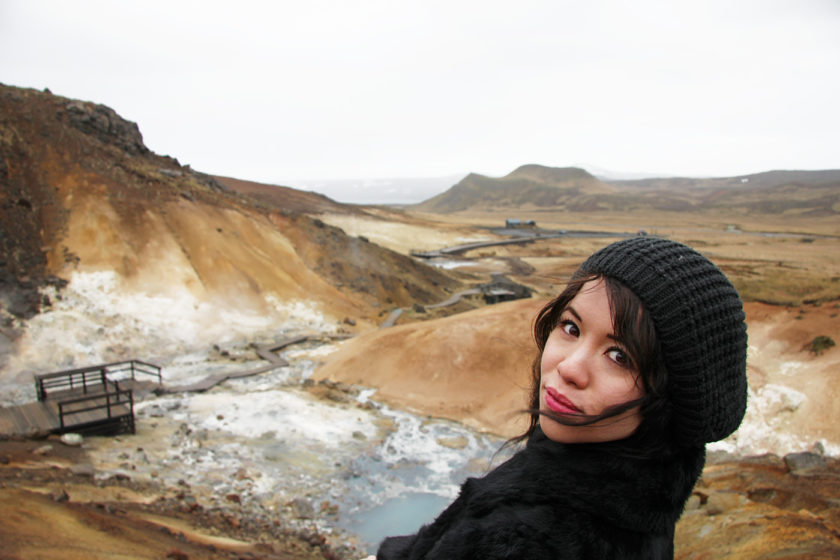
Located along the Reykanes peninsula, this geothermal site is a quirky area known for its bubbling mud pots, steaming mud pools and open fissures. It’s the closest thing you’ll get to Mars on Earth.
36. Visit 'the Man' sea pillar
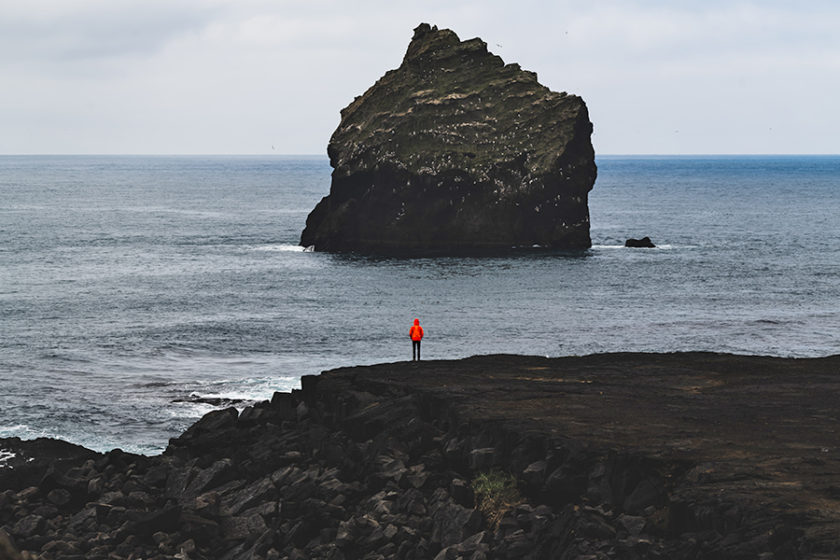
After Seltun, continue exploring the the Reykjanes Peninsula. Along the rugged volcanic terrain of the Valahnúkur cliffs, you’ll be to spot ‘the Man’, a lone sea pillar just off the coast. It stands proudly at 51m high, and was reportedly formed during a volcanic eruption in the winter of 1226!
37. Step foot on the Westman Islands
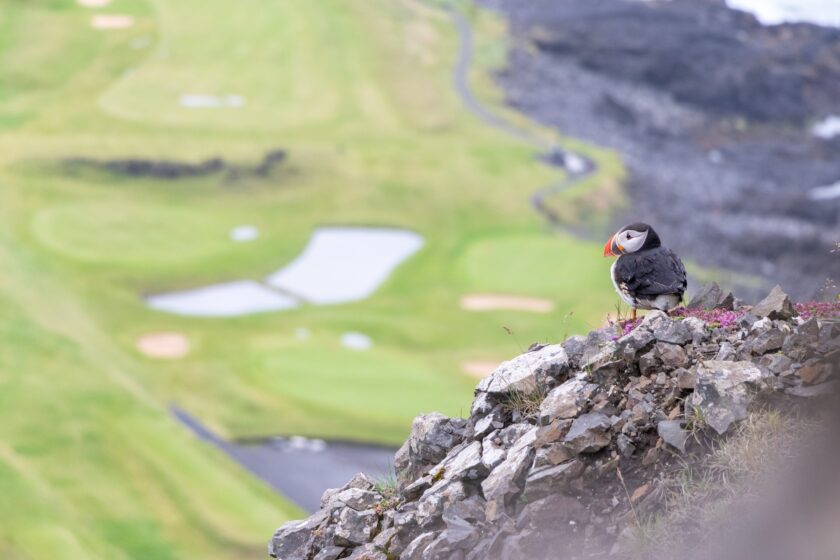
The Westman Islands, also known as the Vestmannaeyjar in Icelandic, is a picturesque archipelago located off the southern coast of Iceland. Comprising about 15 islands and numerous islets, the Westman Islands are renowned for their stunning landscapes, vibrant birdlife, and a unique history shaped by both natural forces and human perseverance.
The name of the islands derives from the dark and intriguing history of the first settlers. Foster brother of Ingólfur Arnarson (Iceland’s first settler) was killed by West Men (who originated from Ireland). They fled and sought shelter in the islands. Ingólfur took his vengeance once he found the men on the islands and hence the name Westman Islands came to be.
38. Walk behind Seljalandsfoss
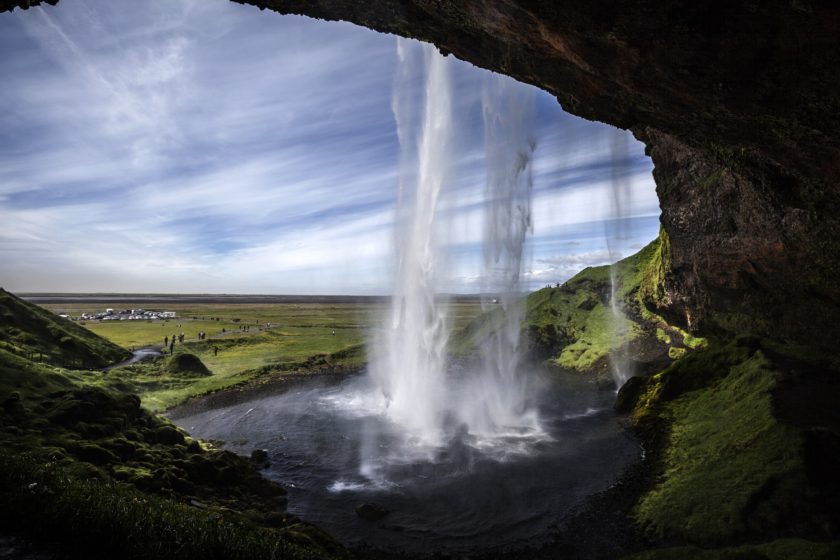
While driving along the ring road it’s easy to spot Seljalandsfoss, a waterfall that cascades 60m over a cliff. It’s one of the very few Icelandic waterfalls that you can walk behind into a mossy cavern for a different, albeit misty-eyed perspective.
39. Catch a rainbow at Skogafoss
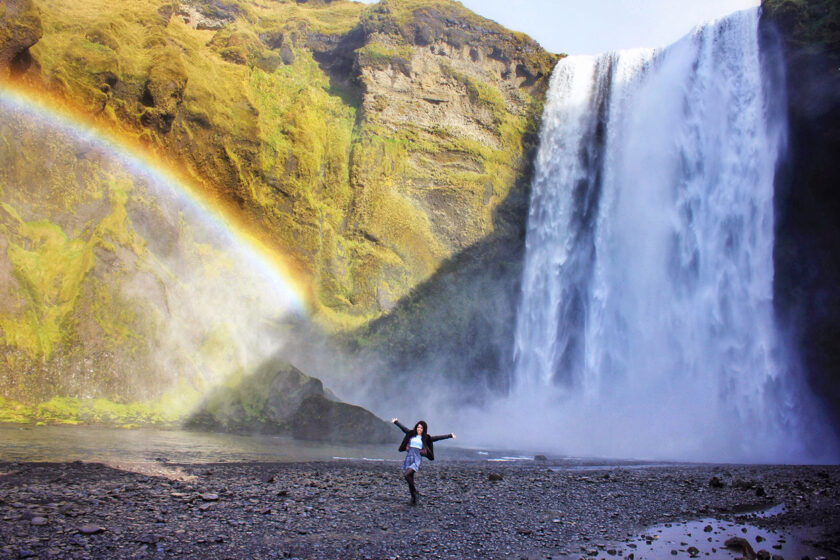
Also known as ‘curtain waterfall’, Skogafoss is one of the most photographed waterfalls in Iceland and needs little introduction. Located only 25 minutes by car from Seljalandsfoss, these waterfalls easy to reach from each other. Let’s hope there’s a rainbow waiting here for you too!
40. Go deep inside a volcano
Big enough to comfortably swallow the Statue of Liberty, the magma chamber of Thrihnukagigur (a dormant volcano near Reykjavik) is a technicoloured subterranean dreamworld that visitors can experience on an ‘Inside the Volcano’ tour. You’re lowered in an open elevator into the depths of the sleeping giant that last erupted 4,000 years ago.
41. Pamper yourself at the Blue Lagoon
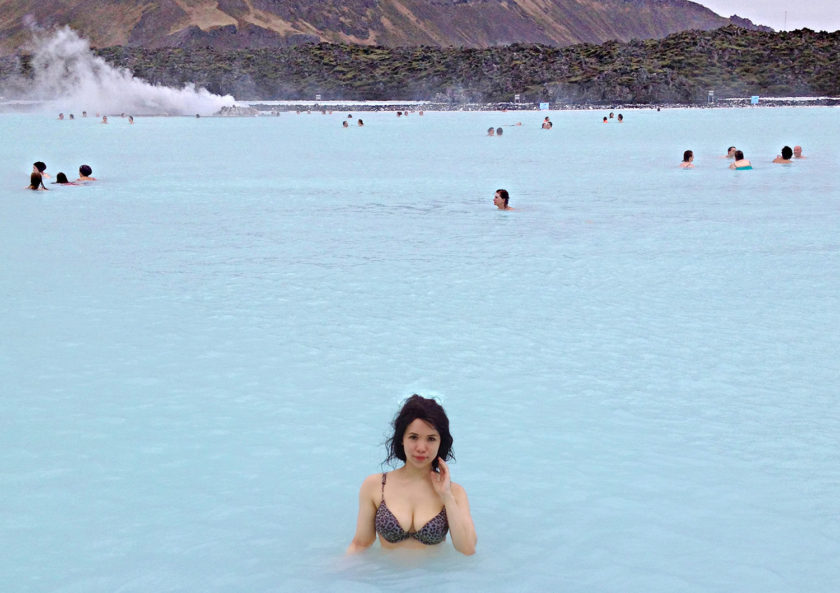
The Blue Lagoon, one of Iceland’s most popular tourist attractions is a fun place to experience the country’s unique geothermal activity. Located nearby the airport, it’s a good idea stopping by here on arrival into Iceland, or as a final treat to yourself before heading back home.
42. Or soak in the Secret Lagoon
If you’d prefer to avoid the crowds at the Blue Lagoon, instead head to the Secret Lagoon. It’s a natural pool located in the village of Fludir in the Golden Circle area and is surrounded by several hot springs, including a little geyser, providing the pool with fresh warm water, maintaining a temperature of 38-40 °C – even during winter! The historical surroundings have been kept natural and simple for a unique and authentic experience.
43. Stay in the cute little town of Vik
One of the most popular destinations in South Iceland is the village of Vík. Situated in the foothills of Mýrdalsjökull glacier, Vík could be described as the capital of the Black Sand beaches. Few other places in Iceland offer as many contrasts in nature as Vik. The peaceful seafront is set along a dramatic stretch of coastline, poised between glacier topped mountains and the eerie basalt stacks which jut out from the water like witch’s fingers!
44. Reynisfjara Black Sand Beach
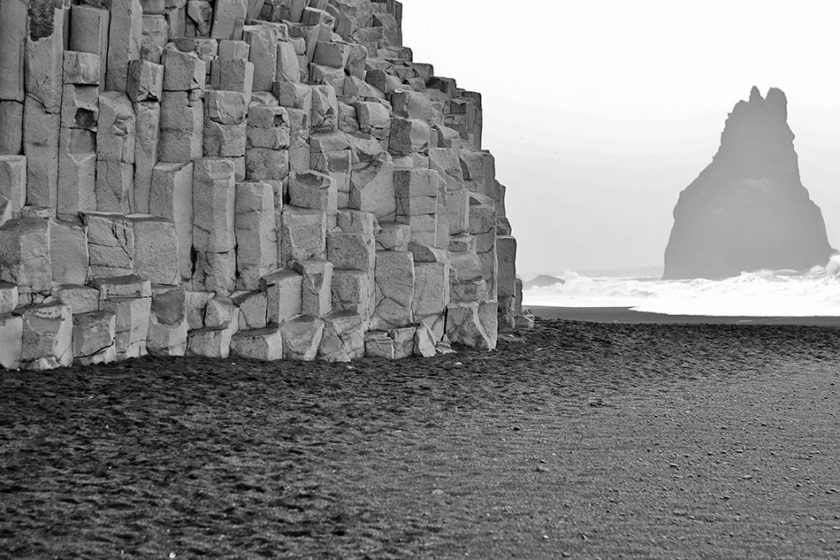
From Vik, Reynisfjara is literally a stone’s throw away – you can even walk to the world-famous black-sand beach. With its enormous basalt stacks, roaring Atlantic waves and stunning panoramas, Reynisfjara is widely considered to be the most beautiful example of Iceland’s black sand beaches.
45. Stop at Dyrhólaey - the arch with a hole
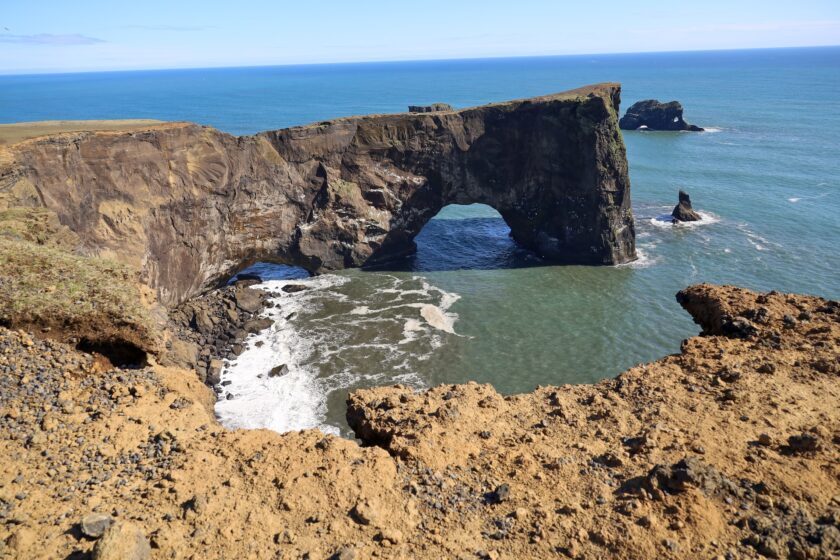
South Iceland is full of geological wonders and Dyrhólaey – which is a promontory that rises 120 metres above the sea – is certainly one of them.
A stone’s throw from Vík, the promontory is exposed to the elements and after years of being pumelled by waves, natural arches have been worn into the dark lava to create the unique appearance you see today. Come rain of shine this place offers an atmosphere allure, but in summer, Dyrhólaey becomes a birdwatcher’s heaven, as puffins nest in the cracks in the cliff face.
46. Hike to Svartifoss in Skaftafell National Park
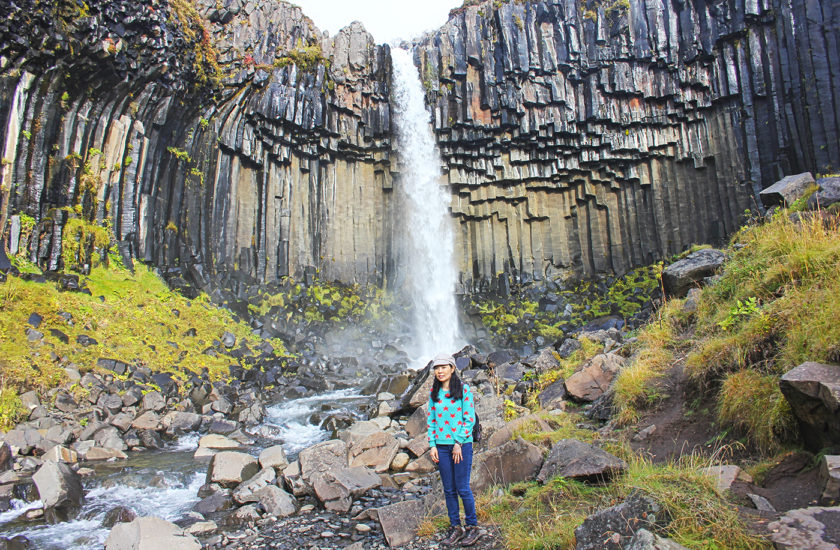
Some Icelandic waterfalls get you gushing superlatives due to their size, the number of tiers, or the fact you can walk right up to them. Others simply find themselves incredible settings. Take Svartifoss for example. It’s not big. It doesn’t make the ground tremble. It doesn’t even bother with rainbows. Instead, this modest 20m-tall horsetail plume has picked a prime spot in an amphitheatre of hexagonal basalt columns.
Svartifoss commands an almost cathedral-like sense of awe – and it’s perhaps no coincidence that Guthjon Samuelsson, the architect of Reykjavik’s striking Hallgrimskirkja cathedral, sought inspiration here. Make the pilgrimage to this revered waterfall at Skaftafell, the gateway to the Vatnajokull National Park. From the visitor centre, an easy two-hour round-trip walking trail features head-spinning views of the falls.
47. Walk around Svínafellsjökull
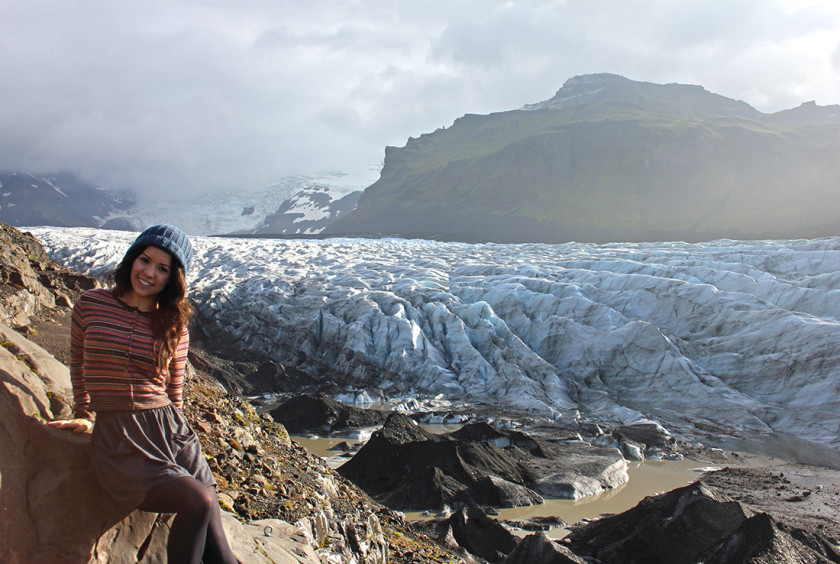
The Secret Life of Walter Mitty opened up Greenland to people who may not otherwise have been interested in going, but did you know that most of the scenes which were said to be in Greenland were actually shot in Iceland? Furthermore, and more surprisingly, the scenes which were set in the Himalayas and Afghanistan were actually filmed in Vatnajökull National Park, Europe’s 2nd largest National Park in Iceland! And here I am perching on the side of a rock next to svínafellsjökull, a glacial tongue of Vatnajökull ice cap.
48. Stand in awe at diamond beach
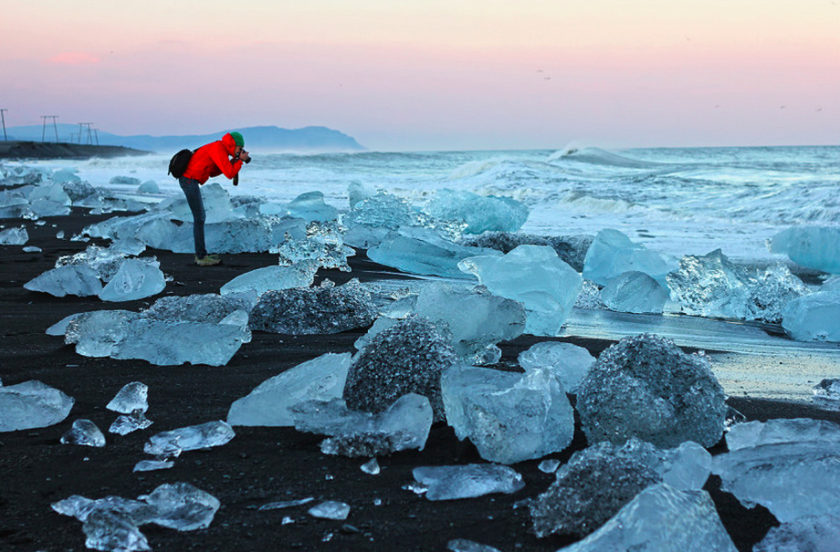
It’s difficult to put the size of these icebergs into perspective; some are the size of houses, whilst others appear like flat, thick ice-sheets. All we know is that once you’ve seen Jökulsárlán Glacier Lagoon, you’ll never forget it.
49. Visit the turf-roof Church in a lava field
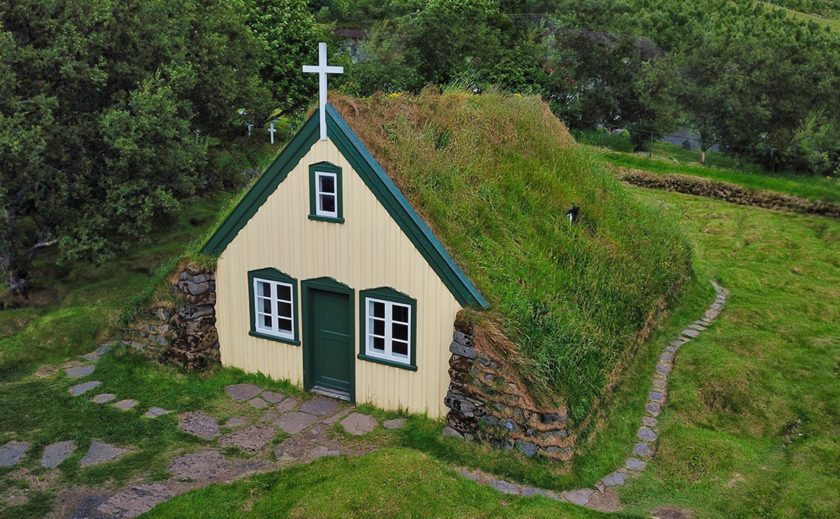
Did you know, with around 32 volcanic systems, 11% of Iceland is covered by lava fields, much clad in moss? This traditional 18th-Century turf church in Hof, Southeast Iceland, was created as protection from the elements and remains one of the last standing in the country today.
50. Go snorkelling and diving
Dive or snorkel between tectonic plates in Silfra Fissure in Þingvellir National Park.
West Iceland
51. Glymur - Iceland's 2nd tallest waterfall
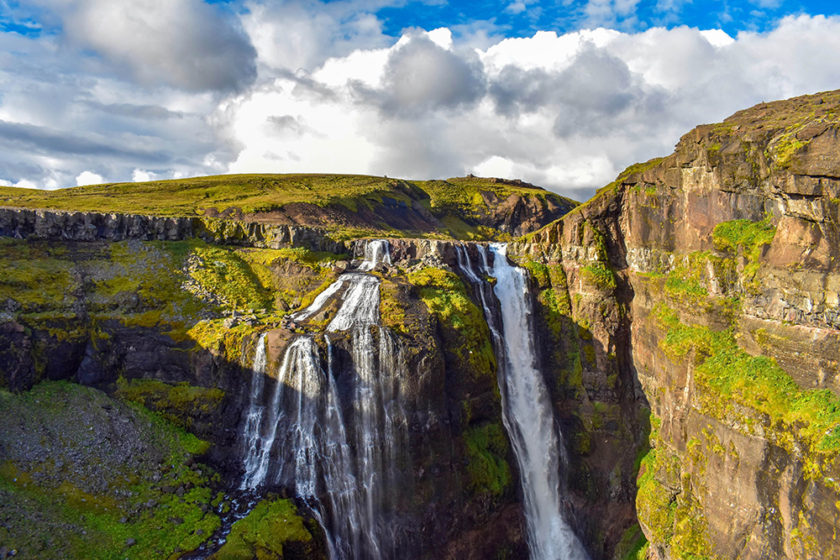
With a drop of 198m, Glymur is Iceland’s 2nd tallest waterfall. Located in Hvalfjordur Fjord (which translates to Whale’s Fjord) is about an hours drive from Reykjavik. To go there you need to drive into the rear end of the fjord instead of driving through the tunnel under the fjord. There is a sign by the road (#47) telling you when to turn right.
The waterfall drops into a mossy green extremely majestic canyon so this hike is worth very minute, and is not that difficult even though you need to face some challenges on your way up.
52. Stop at Hraunfossar for a series of waterfalls
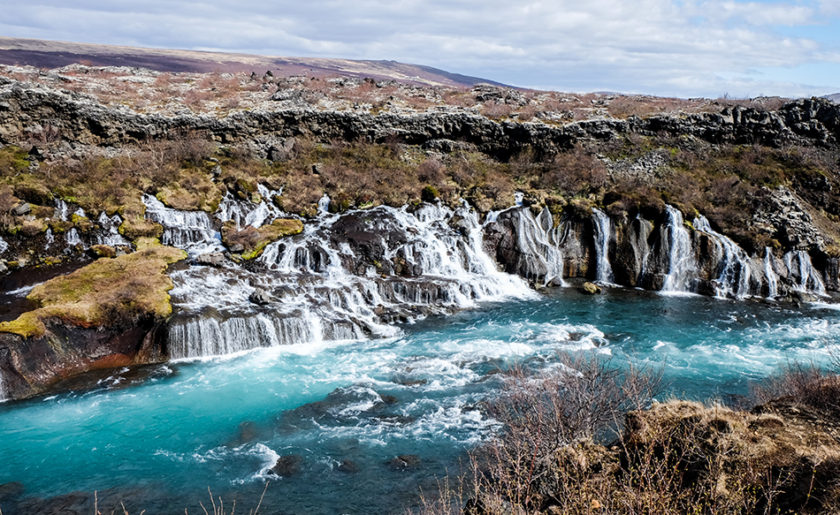
Husafell to see one of Iceland’s most beautiful waterfalls –Hraunfossar. The name of the waterfall translates to ‘Lava Falls’. From Husafell you could also go on a trip inside a glacier… taking you through various ice tunnels after travelling by a massive trunk made for snowy conditions. It’s rather exciting!
53. Kirkjufell - Iceland's most photographed Mountain
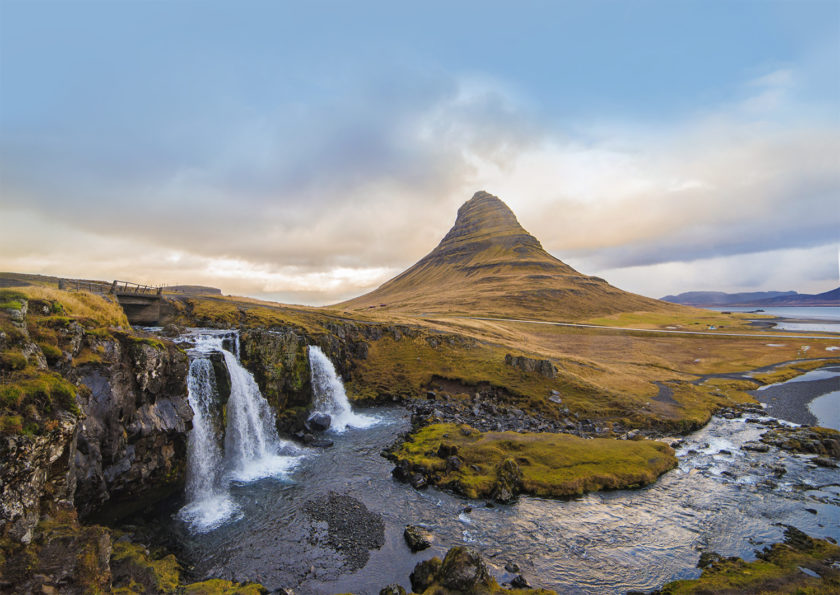
Perhaps the most photographed attraction of Snæfellsnes is Kirkjufell, the symmetrical mountain also known as The Lonely Mountain. It rises 463m above the shoreline and nearby is the beautiful waterfall, Kirkjufellsfoss. This striking mountain and waterfall combination means it’s a highly coveted spot for photographers and instagammers trying to capture Iceland’s unique landscape. That being said, you need to find the right angle for taking photographs, otherwise it can appear a bit underwhelming when you first arrive.
If you wish, it’s possible to climb the mountain but this is recommended only for experienced hikers since the incline is very steep and exposed. Alternatively, there are some nice walking routes in the area that offer gorgeous views and varied birdlife.
54. Visit the fishing town of Stykkishólmur
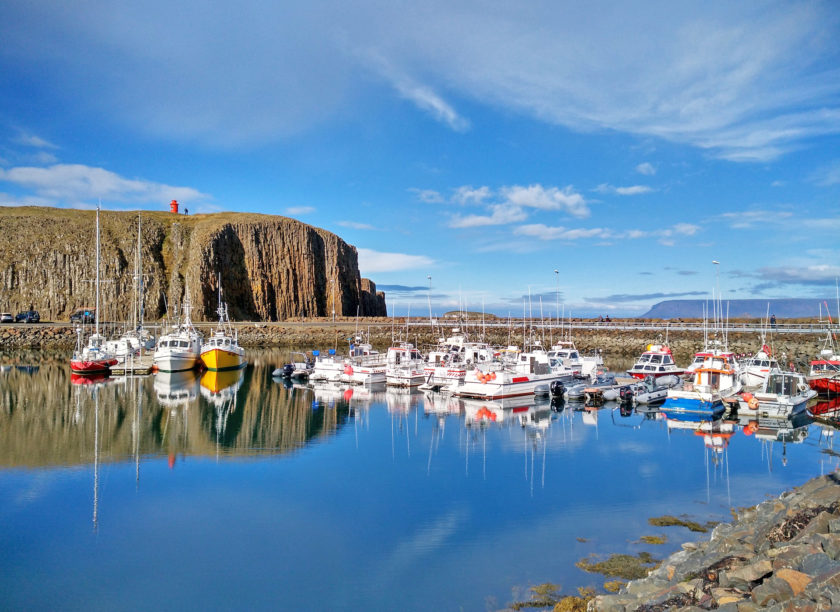
This fishing town is located on a promontory overlooking Breiðarfjörður, a really beautiful bay and is best seen from the bright orange lighthouse which is a short hike from where the Ferry Baldur loading area is located. Afterwards, I suggest getting a bite to eat in one of the cafés or visit the volcano museum located in the centre of town.
55. Visit the smelly but interesting Shark Museum
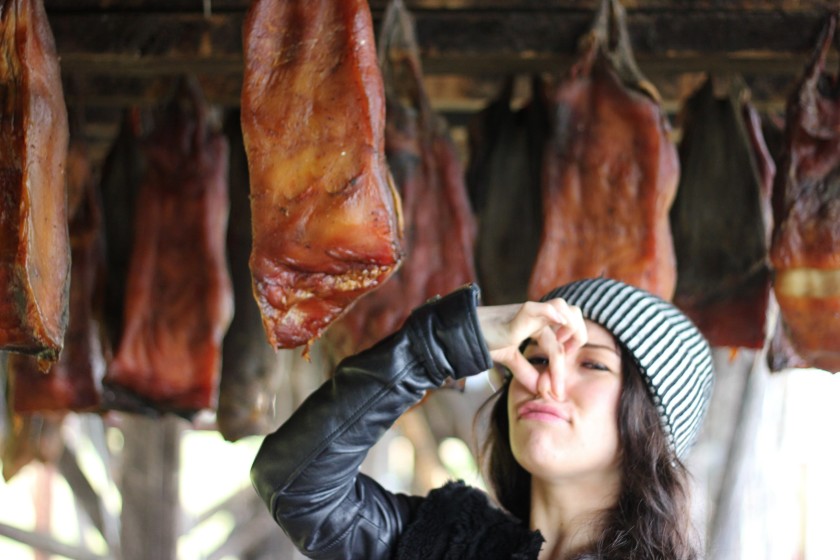
This museum is not like a museum at all. First of all, it’s nestled deep inside a spectacular landscape of lava fields not far from Stykkishólmur so it’s worth going for the drive alone.
Its randomness and shabby appearance is a huge part of its charm. It feels very homely, not curated in a way you expect from most museums, in fact, you might look at something and wonder if it’s actually part of the display or whether it’s just a bit of clutter that’s been pulled out from a desk drawer! The room is filled with an eclectic mix of fishing tools, bones, dried shark skins, as well as taxidermy relating mostly to Arctic birdlife. It’s important to note that the sharks are not specifically hunted, it so happens that some might get caught in the net when other fish are being sourced. You can even try tasting a bit of shark meat – but it’s not for the faint hearted – it’s an acquired taste that even many Icelanders find hard to swallow!
56. Catch the short ferry over to Flatey island
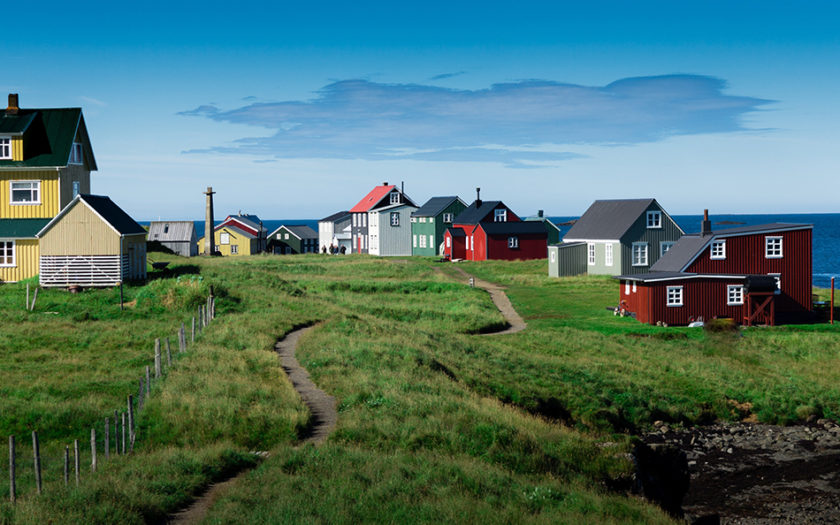
From Stykkishólmur, you can also get a ferry over to Flatey, a unique and remote island that is part of a cluster of 40 or so smaller islands. The island is almost completely devoid of hills, hence the name Flatey meaning ‘flat island’. Furthermore, the nature of Flatey is kept in pristine condition because no cars are allowed. It’s small so you can walk around the whole island and enjoy the wild birdlife which is in abundance there, mostly migratory birds like puffins, arctic terns and more depending on the time of year.
57. The atmospheric views and rock formations at Djúpalónssandur
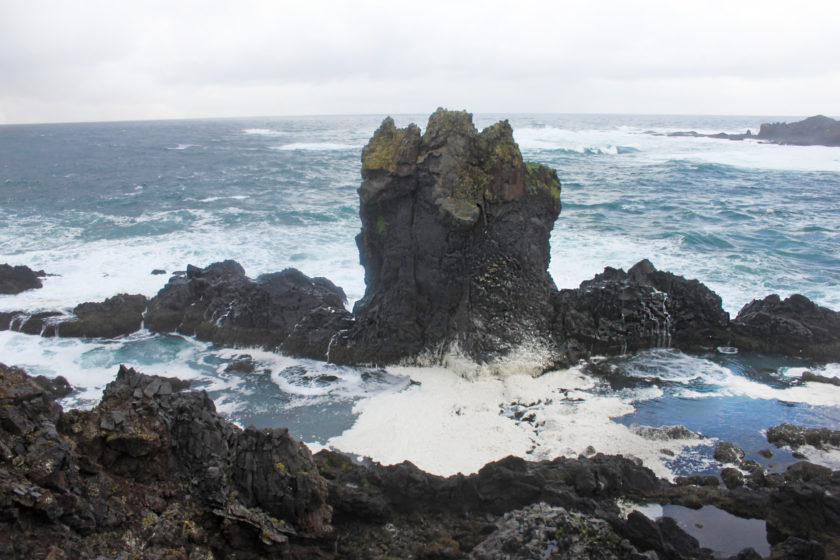
Djúpalónssandur, is my favourite area on Snæfellsnes. I love it. It’s like something out of Jurassic Park. You can walk between interesting lava formations including one with a large hole in the middle, giving you a perfect view to the Snæfellsjökull glacier.
There’s also a beach and if you look closely you’ll probably spot some rusty chunks of metal dotted across the it. Interestingly, these are remains of a British trawler (called The Epine GY7) that crashed into the rocks in 1948, when 14 men lost their lives and some, sadly, were never found.
If you’d like further description of my trip to Djúpalónssandur click here.
58. More basalt columns at Gerðuberg
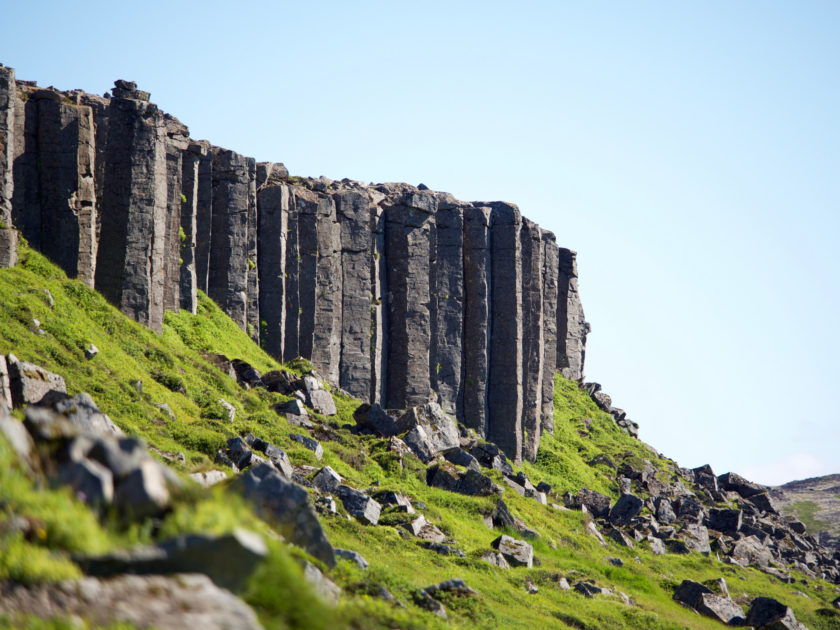
Gerðuberg is long cliff of hundreds of basalt columns standing like an army of pillars. When you arrive, take the path that leads below the columns for the best view of these stunning geological formations. They are mostly twelve to fourteen metres high and about one and a half meters in diametre. Some are even leaning forward giving the cliff a spectacular view as you pass by.
59. Get up close to Snæfellsjökull Glacier
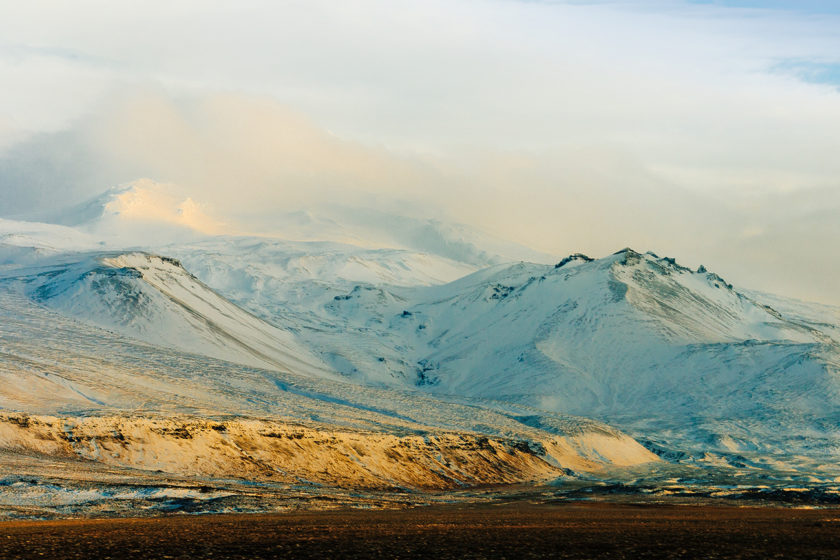
Snæfellsjökull is a snow-capped glacier that covers a volcano. At its highest point, the summit rises to 1,446 m and through activity companies you can reach it by Super Jeep or Snow Cat. This volcano has also been immortalised by Jules Verne’s novel A Journey to the Centre of the Earth (1864), in which the protagonists find the entrance to a passage leading to the centre of the earth on Snæfellsjökull.
60. Svöðufoss
Another waterfall to admire! Svöðufoss is located on the Snæfellsness Peninsula with the majestic Snæfellsjökull glacier looming right behind it. The waterfall itself is 10 metres high and stretches through a beautiful canyon showing the Laxá river in all its glory. It might not be the biggest waterfall (it actually look a bit like a mini version of Skogafoss) but it has many pretty features including some basalt columns too.
61. Walk inside the world's longest man-made ice cave
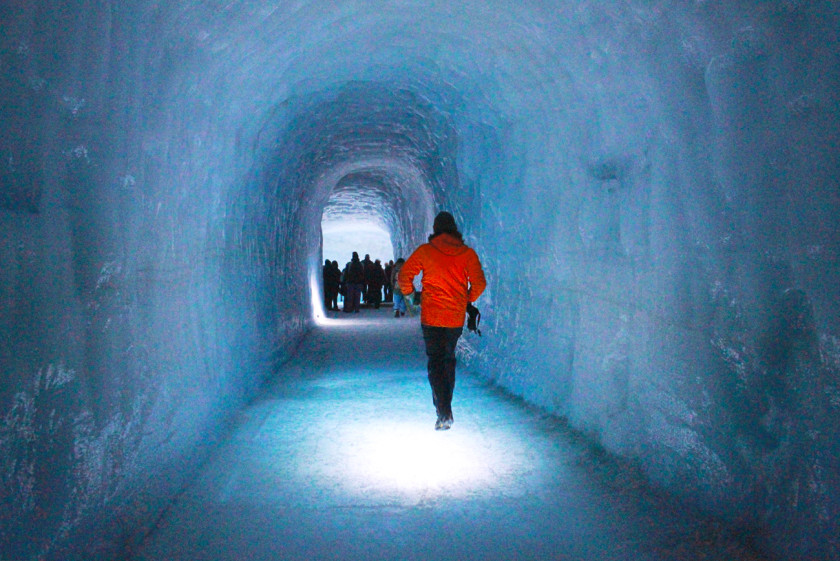
A day-trip from Reykjavik, head inside the world’s longest man-made ice cave, which happens to be located inside the world’s second largest glacier. Newly opened in 2015, the tour lasts almost a full day, but the time you have inside the cave is little over an hour so you can say the journey getting there is a large part of the adventure. The scenery alone offers killer views of Iceland, but the aspect of the journey that really, really raises the bar is the mode of transport – a whopping monster truck.
The Westfjords
62. Capture the beauty of Dynjandi waterfall
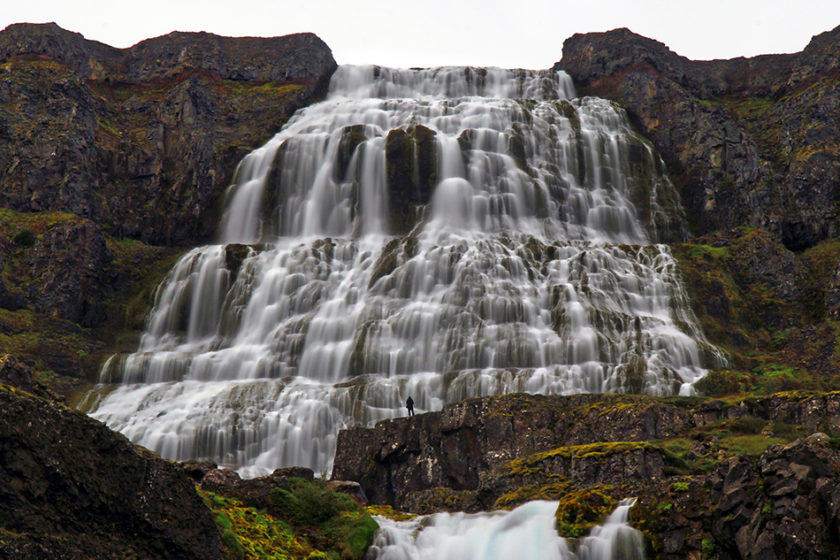
Dynjandi is one of the most powerful waterfalls in Iceland, with cascade falls, doubling in width from 30 meters on the top to 60 meters at the bottom!
If you want to know how majestic it feels to stand by Dynjandi, swipe right to see human for scale!
63. Witness puffins at Látrabjarg bird cliffs
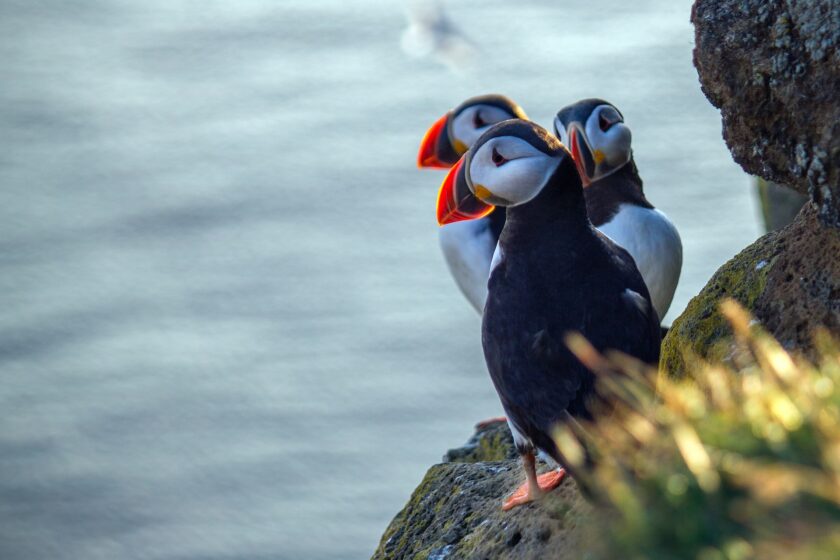
Eventually we made it out to Látrabjarg, which is the westernmost point of Iceland. These cliffs are home to million of birds including Puffins. This was the first time seeing a Puffin and it is incredible how close you can get. But the birds are not the only thing we saw, the area has some of the most breathtaking coast lines I saw and especially with the dramatic and ever changing weather in Iceland it creates such a magical atmosphere.
64. Hornstrandir Nature Reserve
Welcome to the wilderness! This nature reserve is probably Iceland’s most least explored area. Ever since the 1950s, Hornstrandir has been devoid of permanent human residents. It’s inaccessible to motorised traffic, and only a few old buildings and farmsteads now allude to the area’s history of settlement. It is, however, home to Iceland’s only native mammal, the cheeky, yet elusive, Arctic Fox, who preys upon the birds nesting along Hornstrandir’s towering cliff-faces.
There is a hunting ban across Hornstrandir, meaning the fox populations are free to live without the threat of human intrusion. This means they have no fear of travellers, but you should still keep a respectively distance nonetheless!
Inner Iceland (The Highlands)
65. Bathe in the caldera of Askja volcano
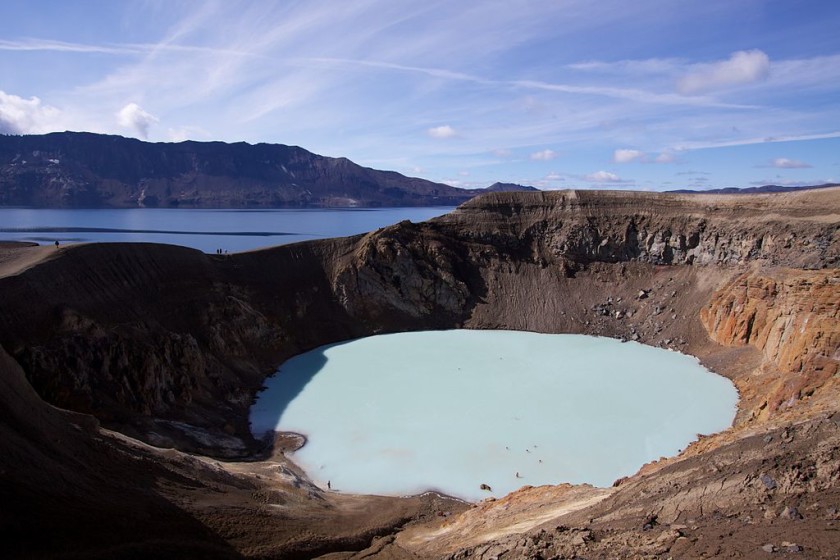
Getting to this famous caldera you’ll need to venture south from North Iceland through ash, sand and lava desert. Interestingly, the area was used during training for the Apollo program to prepare astronauts for the lunar missions. Their main objective in Askja was to study geology but nowadays most people come here to swim in the tepid, stinking water of this huge caldera – how times change!
66. Get off the beaten track to Aldeyjarfoss
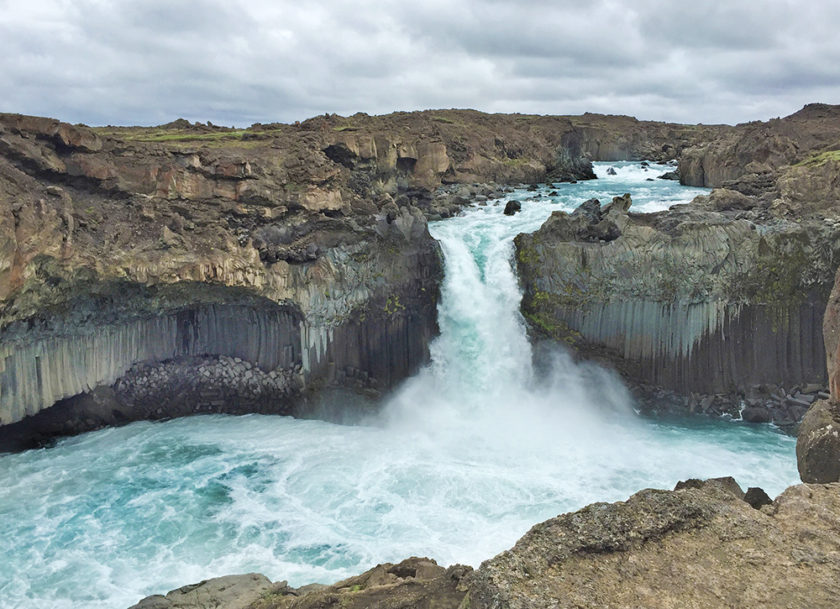
It’s a little out of the way to get here, but it’s definitely one of Iceland’s most unique waterfalls. If you’re not travelling directly through the Highlands then it’s best reached from the North on a day trip. If you want something off the beaten track, and also have a penchant for basalt rock, then this waterfall will deliver that and more!
67. Landmannalaugar
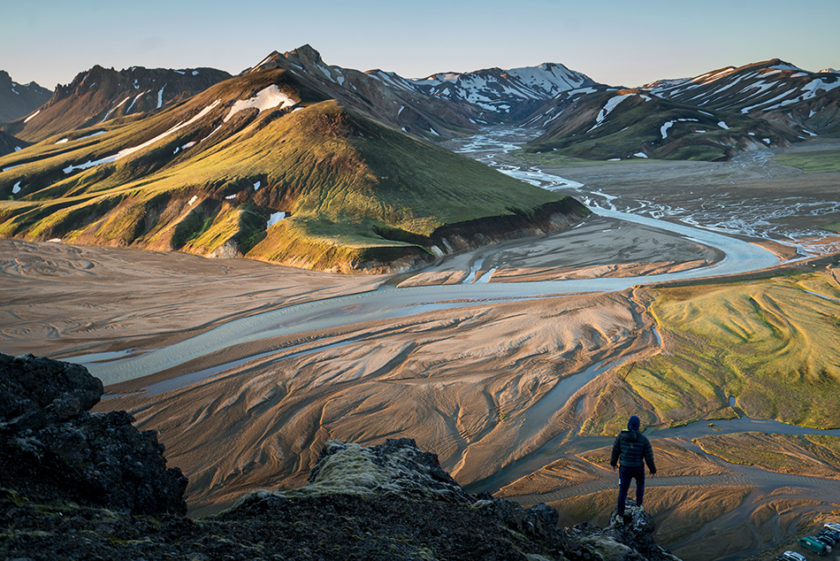
If you’re going to Iceland for hiking, there’s one place you won’t want to miss and it’s Landmannalaugar!
Tip: If you’re crushed for time, or intending to rely on public transport, you could catch a Highland Bus that travels from south to north Iceland, while passing through Landmannalauger.
Not location specific
68. Meet the Viking horses
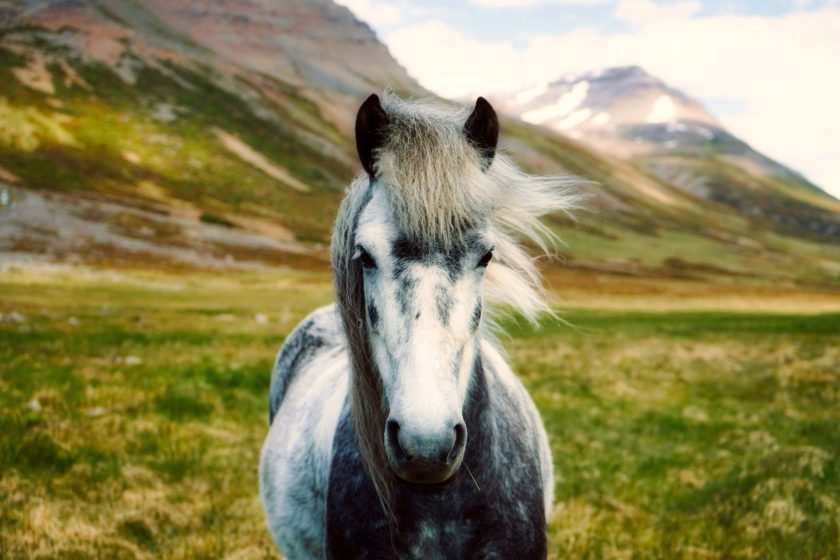
Iceland was first settled by the Vikings sometime in the 800s AD. The horses that are now “native” to Iceland are direct descendants of the horses that the Vikings first brought over from mainland Europe.
You’ll see Icelandic horses everywhere, and no doubt you’ll stop to admire them on any road trip outside of the cities. However, if you’re looking for a more hands-on experience you can always join a horse-riding tour through Iceland’s movie-worthy landscapes. Both Eldhestar and Ishestar operate horse riding tours around some of the most scenic places in the country.
69. Look fabulous in a beautiful Icelandic sweater
Typically featuring geometric zig-zag and diamond shapes, Icelandic wool sweater knitting patterns have a chic look that never dates. Known as Lopi sweaters, the distinctive natural colors of the Icelandic sheep’s wool are utilized to create stunning Icelandic knitwear in earthy tones of gray, brown, heather blue, and white.
70. Experience the Northern Lights or Midnight Sun
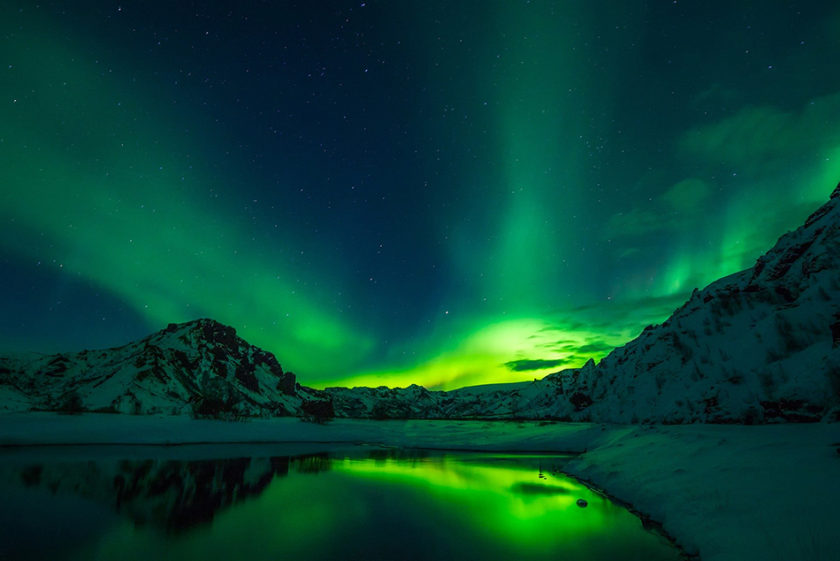
Due to Iceland’s close proximity to the Arctic Circle, it experiences long winter days and long summer days. Iceland is therefore a great place to see both the Northern Lights and experience the Midnight Sun. In the winter, you can embark on Northern Lights tours, with many operating from Reykjavik. Then in summer you have literally have the whole day to enjoy exploring, even can even go on a Midnight Sun Whale-Watching Safari from Akureyri!
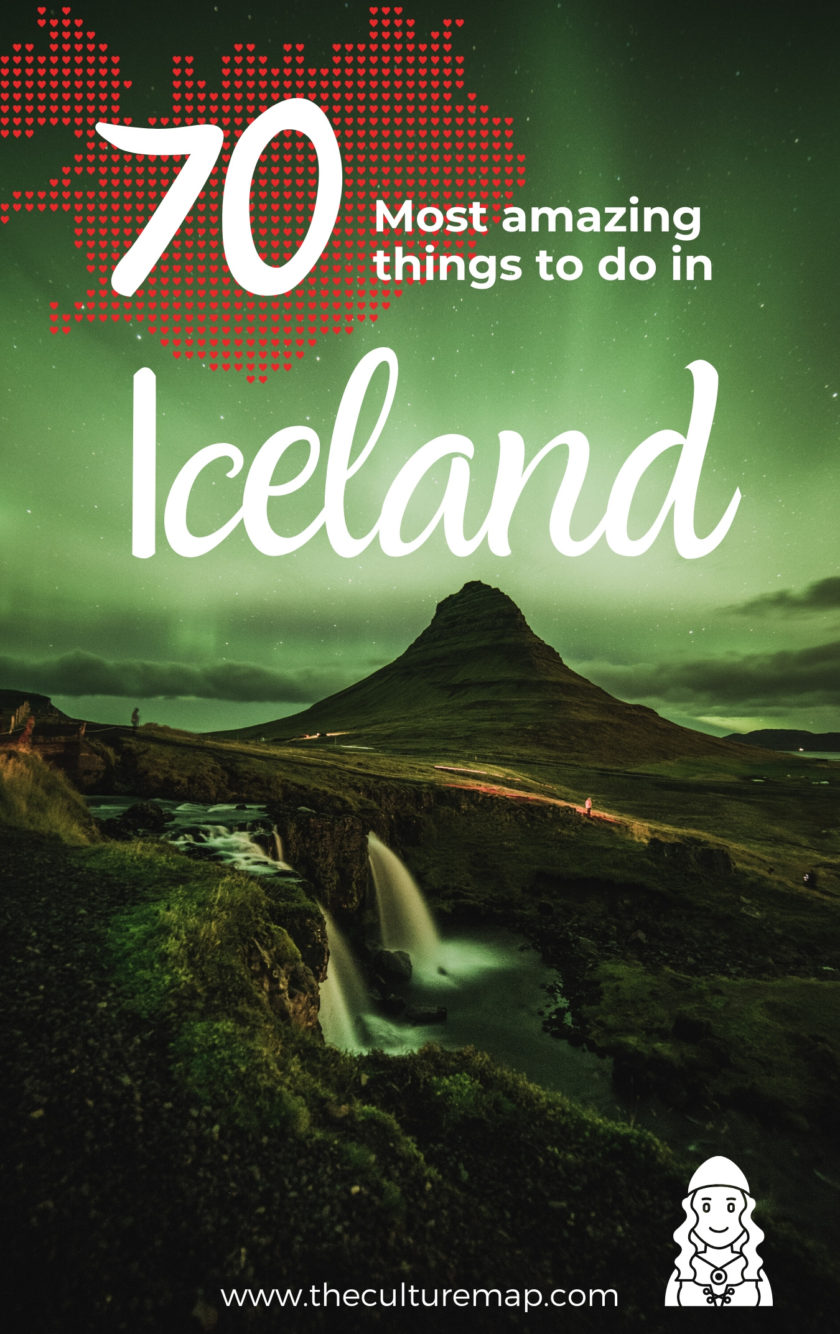


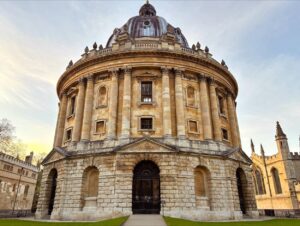
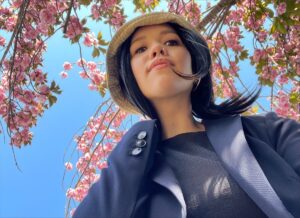
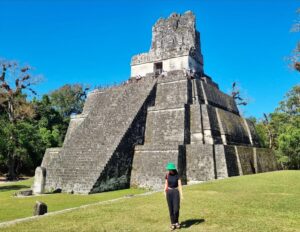
2 Responses
Thank you so much for taking the time to share this. One of my bucket list is Ice land and to be honest, It makes me more feel excited to go there after reading your blog and seeing those great pictures. Also, Shing you are so pretty and cute. Looking forward to your new article.
Ahh glad to hear it! Iceland is incredible, and will not disappoint 🙂 And thank you for the compliment *blushes*